#and who has a similar love for Antarctic exploration.
Explore tagged Tumblr posts
Text
Siiiiiiigh fine
I’m taking this as my cue to finally start Kidnapped
#‘this’ being this guy I’m talking to#he’s a Stuart apparently! and we were talking about uhhh. something nerdy#when I said I had this book on my shelf for nearly a year about the Appin Murder and this guy#bless him. ‘what’s it called??? oh it’s personal’#and now we’re talking about Jacobean history (a subject I’m quite lacking in)#anyways he’s gonna go read it now and I mean. nows a good a time as any!#he recommended outlander to me. as well as the new poldark (unfortunately everyone knows abt me and Cornish history at this point)#I saw the original series but I’ve never seen outlander.#he’s got it on disc so he’s gonna lend me his copy#I heard someone describe it as Scottish Black Sails?? we’ll see lol#anyways guess I’m reading this now#I don’t sound excited I am#I just nervous. what if this is another hyperfixation. why do you think I’ve put it off this long.#I just want everyone to know this is the same man who sang Jacobite songs in an English pub and who sends me pictures of mushrooms#and who has a similar love for Antarctic exploration.#lovely lad#we exchange folk songs like they’re cards lol#I did recommend Flight of the Heron and so we’ll also be swapping CDs lol
4 notes
·
View notes
Note
My secret is that im scared
I’m scared, in my purest form i am scared
The most primal fear i have felt.
My mind is too simple to comprehend the thoughts of higher beings, watching my every move. Judging me. Being able to destroy worlds with a single touch.
Everything is so complex that it makes me want to rip my head out in frustration. And yet i am so morbidly fascinated by it, to where i am constantly blipping in and out of reality, panicking and crying at the thought that everything i do and say is being watched.
I am merely one simple-minded troglodyte being faced with the secrets of the universe
And i hate it
And yet i cant seem to pull away
I understand you so much, truly and genuinely. I has the same exact problem and feeling but yet I can’t explain how else this could be.
It’s simply apart of us. we exist and so does the divine energy constantly surrounding each step and thought of ours. I have a theory of most people on the schizospec simply being exposed to the wrong side of this world, there’s much kindness in the omnipresence that watched - I assure you, yet sometimes the mind does this strange thing of convincing us that it’s dangerous, that it wants harm, or that it’s bad.
Being afraid of the unknown is imbedded in us since birth. The deep undersea, space and what’s beyond the stars, the vast space in deserts and the Antarctic, and nothingness of everything - but to some, there’s an insatiable urge to explore these places. Most stay docile, and that’s alright - finding peace and comfort in what’s familiar to them, tending to their own hearts and surroundings, focusing on the crops of their mind and home. Yet to others, such as I, there’s a roaring flame that beckons to explore. Be the one to find new things and places, to find new ways of thinking and seeing! To be the one who breaks all of society’s rules in the most raw way possible.
and I don’t mean simply “hey! debolish all gender norms, destroy capitalism!!” Although that too I stand by, but.. that’s the most baby step of it all. Why force yourself to even have an identity? Just to fit in with others and oblige with the norms.. why have a name? Why have a face? Why be among those which fail to understand the true importance of nature and beauty of everything!? Nothing is important, everything is important. Everything is important. Nothing is important.
It’s not given to everyone, that much I understand, it’s impossible to be given to everyone, that much you can understand. Not all will have the same mindset or ability, so it’s illogical to assume that they will even try grasp at the understanding, at the concept. Yet.. funnily enough, plenty of such souls exist. These poetic, artistic souls. Deriving pleasure through merely existing and finding suffering the pinnacle of their art. The search for knowledge isn’t a new thing, it’s always existed, and people thrive in different aspects of it. The world is so large! do you know?? The world is SO large!!! And yet.. not one individual is the same. Similar, sure. Nearly identical, sometimes. But the main word is nearly.
Not one person will be exactly 1-1 identical by memories, desires, opinions, wants, beliefs, biological, and aspirations. The main step in kindness is understanding that. Hey - also wanted to say that the core to demolishing all the norms in society is leaving the very foundations and main values of why it ever was a thing - connection, kindness, decency, love, and respect. To be a proud outcast yet still have some knowledge not to go out and fking yell and destroy stuff. Don’t scream by the things you stand for. Don’t harm others (without their consent). And don’t be a damn jerk, you still live here and so try to stay quiet as others are, you know - many of these people also want the same, deep down, but are trapped by a system of work work work. But what I was going to is that all people have their own interests and specifics they thrive in, some in science, some in maths, some in philosophy, some in drama, some in acting, some in art. You can’t expect everyone to be able to understand art the same way you can’t expect all to understand maths and quadratic formulas or not. (P.s. .. so there’s no misunderstanding, I don’t mean the new art ‘culture’, I mean the fact art is something that’s meant to speak from the soul and not be just a cash grab. That’s something I’m sickened by). So ofcourse not everyone will get the other dimensional plane, the fact they’re surrounded by spirits and passing energy, and even feel their own soul, which despite being ever so present in most, is something I admit that doesn’t come to all.
look.. I’m fascinsted with this world beyond ours, but it doesn’t mean I wasn’t scared as fuck. I hid under my blanket like a child at the mere thought and feeling of another presence, but I matured and grew to understand them. Appreciate them, even. I had a mischaracterisation of ‘omg there’s cameras in my home!’ Which I don’t blame for infact I was being watched yet without the questionable intent of humans. I do admit, some spirits can be unkind, but that doesn’t mean all are. I haven’t met much yet, but the few that I have have been nothing but kind to me, helping me along the way. I have been in the presence of one unkind one, which made me soul absolutely fall to my stomach and make me grow with worry and dread, but at the first instance of being told to leave, I did (was walking in a graveyard just to check things out, but even there, I had a spirit express how thankful they were for a visitor, so exited to see someone venture into the far and overgrown path). I know many won’t understand, many won’t even try, and some may even see this as some insanity - but I don’t think that affects me. I am who I am and I will be who I will be. The spiritual world is a dangerous and wild place, and yet, so are humans. If I even had to choose, I’d say humans are more unpredictable. Spirits are much more complex feeling wise yet more intelligent with limited words, I can just say ‘please leave’ and they go away, which honestly surprised me, but I’m thankful for. im quite glad to have some guides for this adventure, so ofcourse I don’t expect anyone to follow my footsteps exactly, but I just can’t help but share this with the world.. my mind yearns to express these things.. and I am so happy for the ability to. I value communication a lot.
oh I could just talk for hours..
#Divine illumination#spirituality#spiritual awakening#spiritual journey#spiritualgrowth#spiritual growth#contentment#meditation#healing#actually divine
16 notes
·
View notes
Text
My boyfriend has decided to start watching The Daily Show with Jon Stewart from episode one to see how it evolves. So in case you were wondering if he and I are similar-minded folk...
Last Lee Tonight (wherein Lee gets slightly personal) Season One, Episode Eight

(original air date: 6/24/2014) Major topics covered: Monarchies, Dr. Oz
Trigger warning: brief discussion of Kevin Spacey/sexual assault; medical issues
"Let's deal with the elephant in the room tonight. I'm sorry that Game of Thrones is not on anymore."
Y'all. It has happened. We have reached the first episode where the only clip of the show on the LWT YouTube is the main topic.

This marks an exciting new era of these recaps... for now. Next week the videos seem to be a bit more scattershot again. Whatever, progress towards the future is being made!
Another major milestone is hit in this episode, as it is the first time that John wears something I would categorize as daring. Let's get "Lee's outfit review and thirst corner" out of the way - pink and purple checkered shirt with dark navy (almost black) coat and matte slate gray tie. I'm giving this a 9/10 because I feel like a shiny slate gray tie would have given it that extra 'oomph', but it is still an excellent look.
We start tonight with me really noticing the Ferris wheel in the corner of the screen for the first time. It's a bold ass Ferris wheel. Was that there before??

Jesus that's a neon Ferris wheel.
This episode starts similarly to modern LWTs, except John says "Quick roundup of the week" instead of "quick recap of the week" to kick us off. I did not realize how ingrained some of his speech patterns and word choices are in my head until this specific phrasing. It's one thing to see something completely different from what you're used to, like in past episodes of the show; this is a tweak I feel like few people would notice, and yet it stuck out like a sore thumb to me.
We start in Iraq, wherein Baghdad has fallen to ISIS. John makes a joke about Kevin Spacey's sex dungeon being the former scariest place in the world that got a huge laugh - three years before Anthony Rapp came forward with his story. His behavior was such an open secret, it's so gross.
The opening segment bounces from Iraq to Thailand, where a coup just occurred and the new regime has started a "happiness campaign". This is the kind of story John loves, absolutely ridiculous on its face with a very real undercurrent of torment because of its origins.
Finally in our early stories, Antarctic tourism! That phrase makes me vaguely ill. John is on top of creating the anti-tourism trailer for them:
youtube
Interesting to look at this short bit in comparison to a much larger exploration of a similar topic years later, Mt. Everest expeditions. Obviously that was a full episode segment as compared to the 3-ish minutes Antarctic tourism gets here, but it's a good illustration of just how much more in-depth John is allowed to go on these kinds of niche topics as the years wear on.
John then speaks about the King of Spain abdicating the throne. ("Who needs decapitations or poisonings when you have a 76-year-old man peacefully resigning?") This gives John the opportunity to mock monarchy, his favorite sport, and to mention the LA Kings, something I did not expect. This transitions into speaking about the general idea of monarchy, how just about every European royal is related to the English crown, and Middle Eastern royalty. He ties it back to the Thailand section as well, to discuss the Crown Prince of Thailand, who is, according to the news, "a buffoon".
Next is "And Now This", which discusses "Political Figures Telling You What They Are Not". Fucking Michele Bachmann shows up again, as does professional dingo Tom Wheeler. Christ I hate Michele Bachmann.
With that, about halfway into the episode (13 minutes), we now get to our main story. Truly, this is the basic structure of a modern LWT!
youtube
The main story is about Dr. Oz, someone who time has made much, MUCH more odious. It's not like Dr. Oz wasn't a complete shithead at the time of this episode - his pitching for huckster diet solutions and miracle pills towards vulnerable people is disgusting. I have so much loathing for people who do this. A huge part of why my health problems are so bad is because, around the time this episode aired, I, and people around me I trusted, were influenced by guys like him, guys selling folksy cure-alls or "conventional wisdom". In my case, this influence caused me to not seek medical treatment for obvious, glaring, red-flag stomach issues for nearly two years, at which point I was actively dying. (I wish that the key for me to go see a doctor had been this episode, but it was not.)
But Dr. Oz got so much worse as time went on. I'm glad that, aside from one joke early on about Dr. Oz's (relative) attractiveness, John puts Dr. Oz's feet to the fire the entire segment. And not just him!
I remember learning about how the FDA is not allowed to regulate vitamins and supplements and being absolutely flabbergasted. Everyone knows that there's hundreds of deaths connected to tainted or irresponsible dietary supplements, and John firmly roasts senators Orrin Hatch and Tom Harkin for taking huge amounts of campaign contributions from the supplement industry and them subsequently killing attempts to regulate said industry. I appreciate the work put in here.
I love how silly the pandering demonstration is. Puts such a massive smile on my face. I would be remiss to not remind you that John Oliver fucking loves t-shirt cannons, and his obvious delight and power trip at holding and using one makes me beam every single time I see this.
Other notes:
Lee, you already did the suit review: Yeah sure I did. But consider the way that John says "regulatory zeal" at 9:52 in the Dr. Oz clip while snapping his fingers and barely restraining his anger.
"Check This Shit Out with Some Guy Named Mehmet" is an amazing title for a show.
I can't believe I can't find the GIF of John getting nailed with a t-shirt cannon from The Daily Show. I think Wyatt shot him with it. I'm glad I remember literally everything about this except where to find the GIF itself.
Sorry about getting a bit personal in this one. I know I don't talk much about my personal life, aside from being like "damn I'm at work all the time", but rest assured I am much better now and in good health. I have chronic illness so I'll never be 100%, but I am leagues away from where I was when my untreated illness was at its worst. <3
#john oliver#last week tonight#last week tonight with john oliver#last lee tonight#i definitely don't want to tag anything else from this episode lol
17 notes
·
View notes
Text
Wednesday, February 28 - Hercules Bay and Grytviken, South Georgia

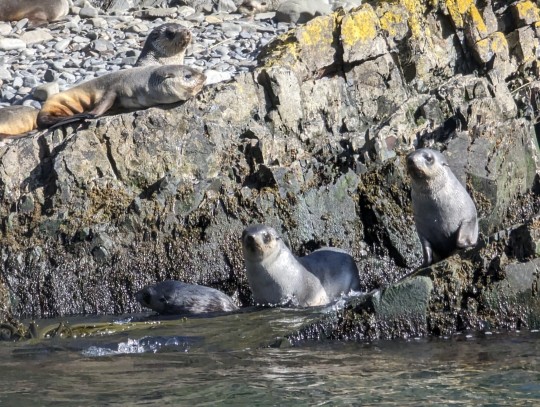

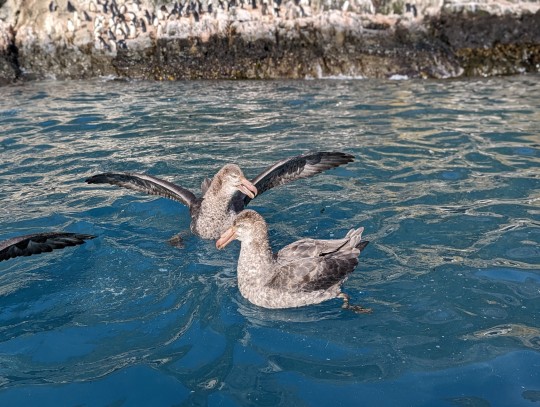

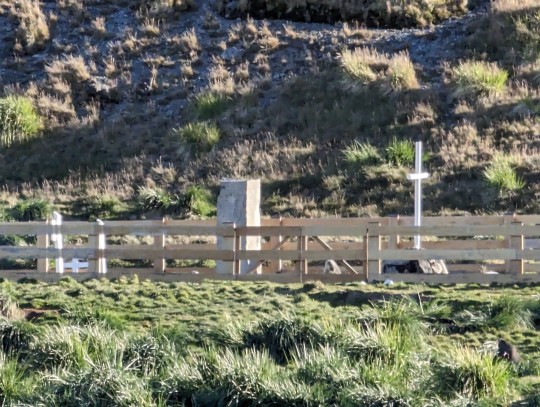
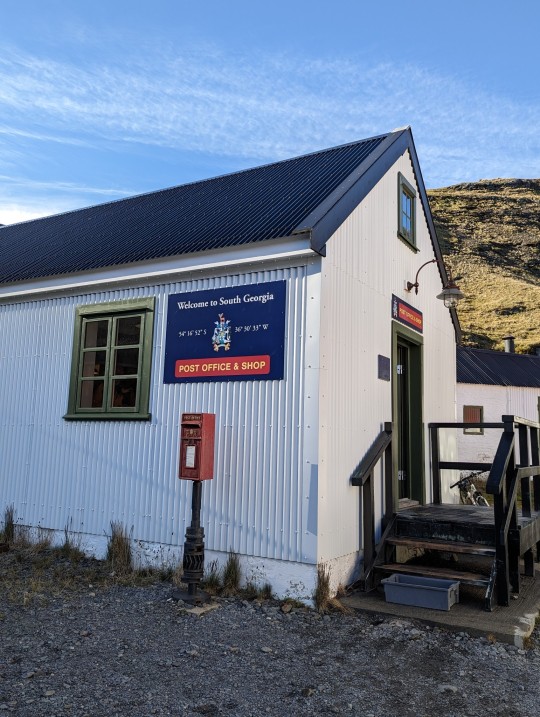



We made it to South Georgia and it certainly lives up to its reputation as a place for scenery and wildlife. Our two sea days getting here were well worth it, and we had lectures, trivia, and other activities to keep us busy on the journey. We spent a bit of time out on deck, watching for birds and whales, and saw lots of the former and two pods of Orcas.
We arrived at a small cove called Hercules Bay, which had fairly vertical walls all around, except for some short beaches leading nowhere. At the head was a lovely waterfall, and as the morning brightened, we could make out lots of white dots on the foliage covering the craggy hills. Penguins. This morning we were the last group to go out in Zodiacs and explore and we watched as the earlier groups slowly made their way along the shore. Obviously, they were finding lots to look at, but until we had our turn we weren't sure what.
Turns out that there were lots and lots of Macaroni Penguins (similar to the Rockhoppers in that they are "crested" and tend to easily climb up rocks), as well as lots of Antarctic fur seals and also some smaller, younger elephant seals. But we actually saw all four of the penguins found in South Georgia, as there was a pair of Kings on the beach, several moulting Chinstraps, and a couple of Gentoos. In addition to those birds we also saw a South Georgia Pipit, which is the only songbird here, and also (as its name implies) found nowhere else. The Macaronis nest on the almost vertical clumps of grass and rock, and were fairly active in the water, too. We did see one whose luck had run out being eaten by a group of Southern Giant-petrels who constantly bicker amongst themselves. They are not beautiful birds, but they do serve a purpose in being a predator of the mainly weak and sickly - but it would be easier if they didn't go after penguins with quite so much enthusiasm.
Many of the fur seals pups are just starting to venture out into the world, and they spend a lot of time "playing" to hone their skills for adulthood. As you can see from the photos, our weather was superb - blue skies, a light wind, and very light waves. Since our weather over was cloudy with over 3 meter seas, this was unexpected and welcome.
From Hercules Bay it was only a short hour or so ride over to Grytviken, our next stop. This is the only place on South Georgia where people actually live, although even here there are no permanent residents. About 10 winter over, while during the summer there may be as many as 40 folks here, working in the Post Office or Museum, working on a scientific survey, or working in the government. We had to go through a pretty intense bio-security check with all our clothes and equipment, as the wildlife is very vulnerable. This is especially true now that the Avian Flu has reached here and traveled into mammals. All cruise ships calling at South Georgia need to stop here before proceeding with any landings.
We were able to land here, but since we were in the last group today ( our color groups rotate which one goes first, etc.) we were slightly pressed for time. We did manage to visit all the pertinent buildings, and get close to the seal pups, but Shackleton's grave was in the off-limits area. The whaling equipment and apparatus is allowed to slowly rot away, but it will take a long time for it to disappear. Before we landed we had a good talk from one of the women working for the Trust that manages the property (and indeed the entire island) along with the government. She and the civil engineer who spoke a day or so ago described the difficulty of both maintaining a historic area, and yet not restoring it. Both women were able to ride over from Stanley in the Falkland Islands with us. Normally they would have to wait for the supply ship, which takes five days to our two, and doesn't have stabilizers.
We watched the sun dip behind the ridge before we made our way back to the ship on the next to last Zodiac. Tomorrow we are heading to Fortuna Bay quite early in the morning. It is predicted to be cloudy, but otherwise similar to today. Of course, it was supposed to be cloudy this afternoon, too, and turned out wonderfully sunny.
I will write a little about Shackleton tomorrow and how his legacy is such a part of today's South Georgia. We were sorry not to get to the grave site, but went by in the Zodiac as close as possible. A note on the pictures - the one with Russ is a life-size Wandering Albatross - they don't look that big from the ship
0 notes
Text
The Guardian Chapter 1
For as long as Odette can remember, the sea has been protected by her people. Merpeople. Her parents, King Mitis and Queen Ida rule the Pacific sea. They are a part of the Royal council, which includes the four other Kings and Queens of the Arctic, Antarctic, Indian, and Atlantic oceans. Not only do they guide their people through everyday life, but they also oversee the protection of their people from outsiders. Outsiders, like the cold ones. Vampires feed off the blood of merfolk because of the rush of ‘magic’ their blood gives them. For a short time, those who drink the blood of merfolk are able to wield a variety of magical powers. That rush they feel is like a drug, addicting and dangerous. Once you taste the blood of merfolk and experience that rush of energy like never before, you build up an intolerance to it and need more blood even to get a hint of that magical power you had on your first try. There’s even a black market out there for merfolk blood. Those willing have their blood taken, similar to how humans donate blood, and are then paid a hefty fortune for their contributions. It is heavily discouraged because a lot of merfolk have been trafficked for their blood just because of how lucrative the ‘business’ is.
All of this is just another reason why Odette’s parents forbid her from interacting with humans. Constantly, she is being told that should she come across a struggling human in the depths of the sea, she should carry them to shore and leave. Obviously, she must make sure they are unconscious or can’t see her before she saves them. Her duties are to not extend to talking or interacting with humans at all. This kind of life can be isolating for someone like Odette, who just wants more outside of her palace life. This is why, when she turns 18, she wants to ask her parents for permission to explore the human world.
Y/n POV
My fins float aimlessly in the water as I pace back and forth. Bubbles float to the surface constantly as I don’t stop moving. Today is the day that I ask my parents to let me explore the human world. That’s all I want. I’ll be a good girl after that. They’ll see how good this will be for me. Hitting my fist into my palm with a definitive motion, I propel myself to my parent's chambers.
“Mother, Father.” There’s a slight quiver in my voice as I address them. I bow my head in each of their directions.
“I would like to ask something of you both. I hope you will hear me out before saying no.”
Mother spoke first, “Of course dear. Anything.”
Father nods his head in agreement and with a gruff but loving voice says, “What is it, sweetheart?”
Anxiety sweeps over me, I almost can’t get the words out. It consumes me, making me forget about asking and not upsetting them. However, the other part of me, the courageous and adventurous part of me wills me to stay and gives power to my voice.
“I’m turning 18 soon, as I am sure you’re well aware…”
“Why yes, your big day is coming. Your father and I are so proud of you. Soon you’ll be running this kingdom with your wisdom and grace.”
“Precisely. For my big day, I wanted to ask for something special. Something that will last me a lifetime. I, I want to explore the human world for 1 day. Before you say anything, please just listen. I believe that I can help our people and protect them if I know more about the different types of beings out there. I want an adventure of a lifetime before I rule. I mean, didn’t you guys have an adventure before ruling this kingdom? I want to have stories to tell my family and friends, just like you guys. I promise to be safe and diligent out there. I’ll even bring a guard of your choosing. Please! I haven’t asked for much in life. Please say yes!” I clasp my hands together, trying to calm my breathing down, my eyes squeezed shut from anticipation.
Both my parents glance at each other, worrying in their eyes. The room is in deafening silence. Finally, father speaks.
“We knew this day would come. We’ve filled your mind with endless stories of our adventures and tales. It makes sense that you crave one yourself. We shall agree to your request, however, we have some requests of our own before we let you go. First, you must take Sebastian as your guard.” Father holds his hand up to stop me from protesting his guard pick and continues.
“Second, your trip is to only last no more than 24 hours. After that, we expect you to be home or we will send the cavalry after you.”
“Oh, he’s not joking dear about that.” Mother puts a dainty hand in front of her mouth to cover her giggle.
After giving his wife a side eye and smile, he continues, “ And lastly, we shall go over some ground rules on how to behave in the human world and as well as blending in. We shall go see our trusted sea witch for a potion to give you legs.”
I engulf both my parents in a bear hug. Tears of joy almost escaped my eyes. Ecstatically, I thank my parents.
“Thank you thank you thank you! You guys are the best parents. I promise to be safe! Especially if I have Sebastian.” My words are laced with nothing but excitement.
Sebastian is one of my parent's most trusted guards. He doesn’t say much, just a grunt and a nod here and there. But that won’t stop me from having the time of my life.
#paul lahote#paul lahote x reader#paul lahote x y/n#paul#lahote#twilight#Twilight series#twilight saga#stephenie meyer#stephanie meyer#werewolf#werewolves#mermaid#xreader#The Guardian#guardian#forks washington#shape shifter#quileute#Quileute tribe
43 notes
·
View notes
Note
/Happy vday, mun! curious to know why you ship jewel with grimmjow. What's the story there?
|| Asks || @justakon ||
💙Happy Valentines Day to you too! 'u'💙
WHEW OKAY GRIMMJE HOURS LET'S GO!
//It’s long and I’m sorry. 8(
-- First, background context I think will be useful.
From Jewel’s feral scrapping and political stirring in her Rukongai days, to gaining her zanpakuto in Shino and entering the Eleventh division, violence has always been a part of her life.
Jewel’s zanpakuto spirit, Hyouhakyoku, pushes her to her limit on the daily to simply exist as she does. Hyou is a relentless, biting energy that refuses to accept her wielder unless she dances to the same, wild beat at all times. As one can imagine, such a state of being is taxing to reign in when she doesn’t want to be in that state all the time but her mind is – nor is it socially acceptable.
Anger, bared teeth, bleeding, adrenaline, and war are all wound into her reflection – that beast has always been there and it’s an integral part of her soul’s foundation.
On the other side of that coin, we have a soul who’s chasing the freedom of the Antarctic winds – a woman who desires a disconnection from all things that threaten to tie her down. She craves to explore the earth pole to pole in her solitude, yet is chained to her duties in her division and the Gotei.
She’s bound to rules, responsibilities, judgment, and her past in her current position. She’s made promises about controlling and finessing her zanpakuto and she’s slow to realize that she cannot keep her word, and it’s enraging, and it’s Tuesday morning and she has another day of work to tackle.
Do your job. Get your shit together. Why are you angry all the time? Wanna hang out sometime? What Lieutenant can’t control her own blade? You doesn’t belong here. Let’s fight. I need a medic. You don’t know what sparring is do you?
She’s content as a quaking glacier on the verge of setting off a tsunami.
-- In relationships.
Jewel had a couple of relationships under her belt before meeting Grimmjow.
Her first partner, Kakós (v: TBTP), was a belligerent, seductively veiled monster. He reeled her in early into her entrance of the Eleventh. He spoke her combative language and knew exactly what to say and do to make her shake.
Unhealed trauma ate at him for years prior to meeting her, and her fresh face was the perfect thing to vent on. She accepted it at first, because violence was the way of the game in the Eleventh, right? He imprinted on her that it was the same way in love, and especially in the Eleventh.
She couldn’t take his push and pull lightning storm for too long. By the end of the arc, they broke up through a fight where she severed his arm (a symbol that he would never lay a hand on her again. It was his last fleshy arm -- he only had his metal one now.)
Her second partner, Tetsuji (v: frostbitten soul), was a recent transfer from another division. He was charismatic, playful, and flirty with her. Jewel, being traumatized from Kakos, was incredibly guarded around him.
Any sort of romantic or sexual intention towards her set off her alarm bells, and even though Tetsu was friendly, she could read the undertones, and she wasn’t having it. She shot him down multiple times for any romantic outings, though she eventually came around to doing something with him as friends.
Jewel found that she enjoyed hanging out with him so she did it more often. They shared similar interests in nature, art, and weaponry and a friendship was surely built over a brief time.
Something that made her question her feelings for him was how he treated others around them. He was genuinely a good person and got along with others for the most part. He was sweet and patient with her and handled her with a lightness she had never really been shown before. Tetsuji didn’t wear a mask like Kakós did; nothing about him was a facade.
For the first time, she thought, ‘Could I love someone like him? Could I have a love like that? Am I made for that?’ and decided to take the plunge. Of course he said yes. It felt right, too. One would think they were perfect for each other with the way they talked to and lit each other up.
They clashed in a few areas. Jewel’s teetering control with Hyouhakyoku made her body inhumanly cold (and frostbitten at times) to engage with sexually and it caused frustrations for both of them and embarrassment for her.
By the middle of this arc, her taste for danger and violence proved to be too much for him. She was too reckless and goading for fights during this time. Masochistic and physically abusive, Jewel subconsciously expected Tetsuji to flip on her like Kakós had and projected her unhealed trauma onto him. Tetsuji caught on to that and blew up at her over it. He was hurt over the notion that she believed he was hiding his true self from her and trying to 'poke holes in his mask' with violence.
She was just too unhinged and wild for Tetsuji to handle and they broke up over an argument.
It took Jewel some time to come to terms with the fact that she was in the wrong in that situation and tried to get Tetsuji back but he would not have her. It was a huge wake-up call to Jewel that she was.. not okay. She wasn’t okay in so many ways and it crashed upon her in an emotional wave. Had she ever been well?
She was alone again. She didn’t know how to ask for help. She isolated herself, left with a dark sea of questions only she allowed herself to carefully navigate. It was a deeply reflective time for her, and a transformative one.
-- Grimmjow.
Jewel met him during her Main Timeline arc (v: frostbitten soul), near the end of it.
In Hueco Mundo, where it’s do or die, Jewel is in an environment where she is at home with her instincts. Her zanpakuto has room to breathe and assume its more natural state. Here, she felt a sense of freedom to let loose and be herself. The desert wasn’t her home in the same way a frozen desert was, but she felt like she could fit in to a place of lawlessness. Survival. It’s what she did best.
He caught her attention during a hunt. It wasn’t the first time Jewel had seen wild hollows be torn apart but the way he moved caught her attention and she found herself studying him.
An electric presence. Swift. Unforgiving. Jugulars wound through a clawed hand and a bloody smile. A buffet for one.
She wondered then if she would have been another morsel on the side if she danced with that. A foolish part of her wanted to know but a smarter part knew better than to try.
He noticed her but it wasn’t a death match on sight. Jewel was at a point where she did not attack anyone who did not attack her first – which was odd to him, that a Shinigami would see him and not immediately think ‘oh shit evil gotta do summin about that--’ It was also weird that she was seemingly by herself (she’s got an arrancar shaped taxi hiding away but that’s not important here asdf).
There’s an inherent curiosity there and questions that go unanswered but they banter nonetheless, and she eventually gets the opportunity to show off her own skills in front of him.
Jewel doesn’t behave like a typical Shinigami. Enemies aren’t enemies because of how they look nor does she judge their actions unless they affect her personally. Everyone is on a neutral slate and are defined by their actions through her eyes. Once crossed, she’s zero to sixty with her violence, and has a rather animalistic way of fighting (like he is).
From the outside, she appears every inch dangerous and like a walking environment altering weapon. She's not soft. She doesn’t pretend to be something she’s not.
Vulnerability is off the table at the beginning but they’re drawn to each other’s wild nature. Jewel sees a kindred spirit in Grimmjow’s need to keep himself at the top of the food chain, his rebelliousness to the professional system he was placed in, and need for autonomy. Freedom.
They both carry a demanding presence. There’s no question in their minds that the other is dangerous, but they retain a curious fascination with each other despite that. The striving for power courses through both of them and to watch the other fight is stimulating, coupled with snarky shots at the other amid it all (how fun.) It goes unspoken that if one crossed a boundary that it would be a bloodbath for the both of them. It’s a quiet level of respect.
They crave passion, in different yet reflective ways. Grimmjow, a harbinger of Destruction, seeks to crumble foundations in his outer world and build a throne for himself out of the rubble; a lone king in the moonlit darkness. Jewel, a harbinger of Ice Ages, who carries potentially world altering power, wields herself as a Creator as she crumbles foundations within herself to sculpt herself into something new, finessed; the queen of her own power.
When Creator and Destroyer meet there’s an unlimited potential for change – one way being the view that shinigami and arrancar don’t have to be ‘natural enemies’.
They’re both wanderers, hunters, and killers who come to read each other’s body language well. It's familiar, yet entirely foreign. They come from different worlds.
They don’t need each other, nor demand anything from each other. There is no tying the other down they can come and go as they please. There's that sense of freedom right there. Both would be just as fine on their own, but I think they would find a sense of home in each other that says, ‘Oh… someone that reminds me of me,’ and I think it could be a deeply platonic thing or something that could become romantic. It would be a slow burn for both of them, but they spark a flame in each other’s soul regardless of the outcome.
I think I could mayhaps type more but
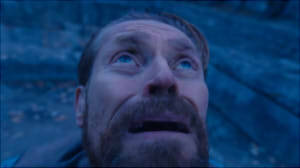
I'll share some headcanons about them here if you’re interested, just a bunch of other little reasons why I love Jewel and Grimmjow: 1, 2, 3, 4, 5, 6, 7, 8, 9, 10, 11
Thank you for sending this, @justakon ! c:
11 notes
·
View notes
Text
some expectations/predictions for the egg plot just because i like listing things and i am, quite frankly, bored:
puffy gets infected next and seeks the syndicate's help before the infection got worse. by doing this, she accidentally spreads the egg's residue in the antarctic, causing a sprout to grow there.
purpled involvement? bad did pay ponk to get purpled to assassinate puffy, so i'd like puffy's first canon life to be taken out by purpled.
eret has to be next on the chopping block after puffy. the entirety of the greater dream smp seems to be getting infected, so why not have the king get infected too?
RED VELVET HAS TO BE PART. i know not everyone knows who red is, so for context, red is a good friend of the friend group of dream's who is also ant's boyfriend. dream wants smaller content creators to gain recognition so it'd just make sense he'd want red to join the server. plus, his entire theme is RED, so he seems like the perfect candidate to be the guy behind the bloodvines growths.
with red involved, i also want to see some ant character exploration. if red and ant are willing to roleplay some relationship shenanigans in the egg plot, and if the egg is meant to provide everyone with anything they desire, i'd like to see ant desire something akin to companionship. this would make sense as to why red would emerge from the egg in the first place, and i just think it'd give ant a cool character arc once the egg lore wraps up.
bad self-sacrifice? it just feels like it's building up to something like that. skeppy and bad's lives are apparently connected, and if skeppy is a lost cause, bad could potentially just. sacrifice himself if it meant he'd protect everyone else.
if the egg dies, i'd still want to see red as a character who has similar powers to the egg but is much less evil in nature. maybe he'd find a sense of purpose/a touch of humanity via ant?
the prison should be infected soon. the egg itself breaks obsidian and i'd love to see it break dream free from his confines. that being said, i do expect dream to be afraid of the egg because he's shown distaste for it when the bloodvines first appeared. so while dream is free, he's still trapped thanks to the egg being one of its weaknesses.
SYNDICATE VS EGG PLOT? it feels like it's leading up to that eventually. plus, it'd be an interesting fight when you realize that you can't really DEFEAT the eggpire, but you need to find a way to fight them without murdering then, find a cure for their infection, and defeat the egg without any information as to how it works. i mean. unless dream knows about the egg, and he teams up with the syndicate, which i think is Very Cool considering wilbur might as well be part of their group too.
bad's a very emotional person so i won't be surprised if he actually cries in one of these roleplays. bonus points if he drops the f bomb at a certain point.
sam, when you do get infected, please commit to your creeper roleplay and imitate the fire creeper from the elemental creatures mod where you just explode and turn into fire from time to time. it'd be so fucking cool.
#dream smp#badboyhalo#skeppy#awesamdude#captain puffy#dreamwastaken#velvetiscake#the eret#purpled#mcyt#long post#antfrost
189 notes
·
View notes
Photo
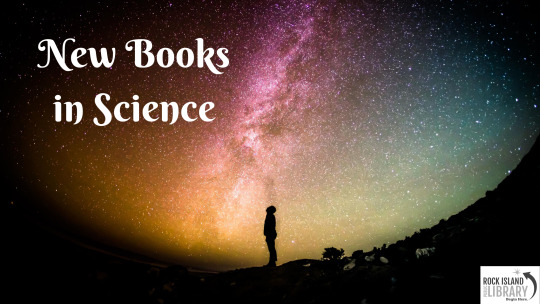
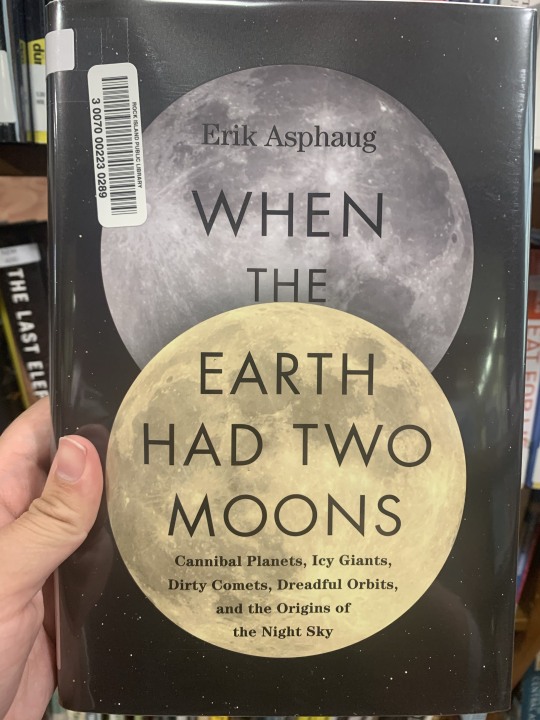
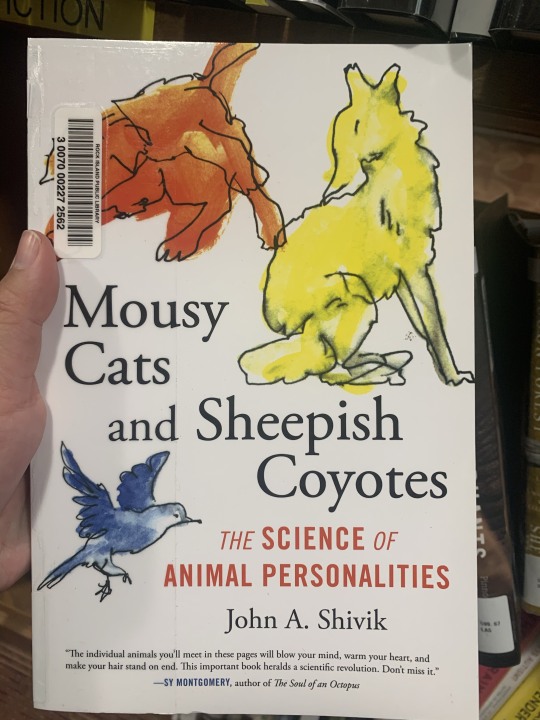
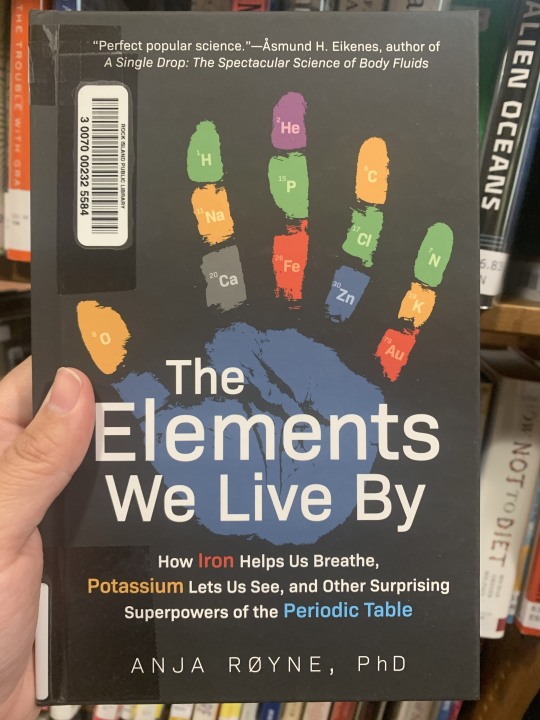
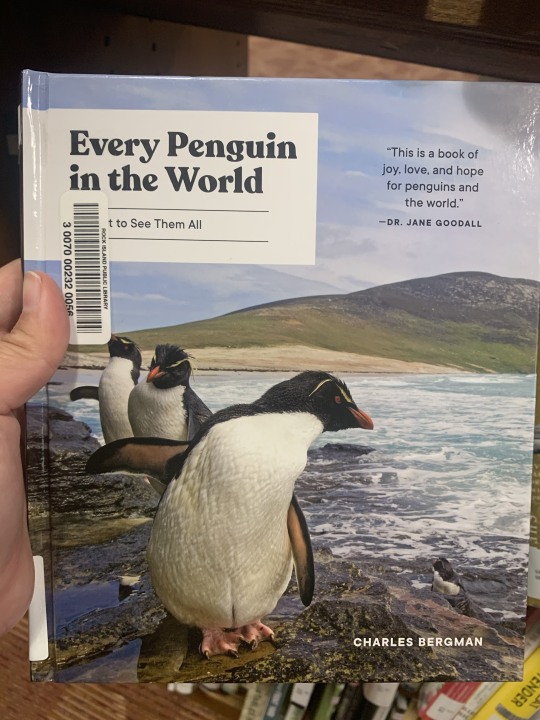
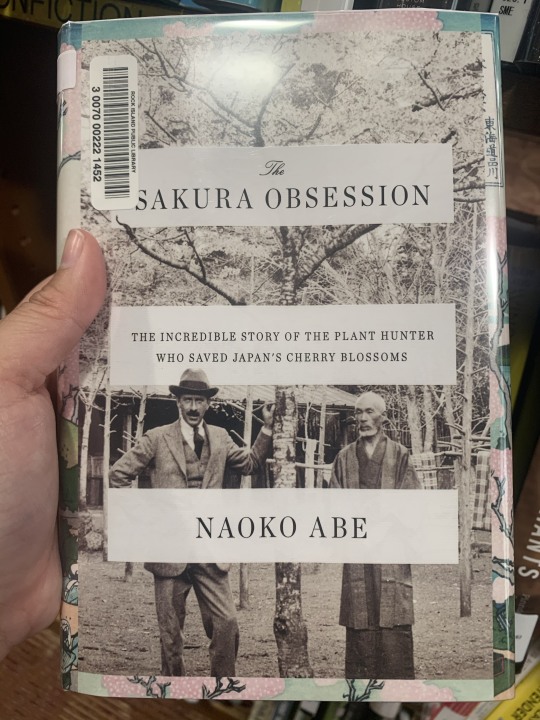
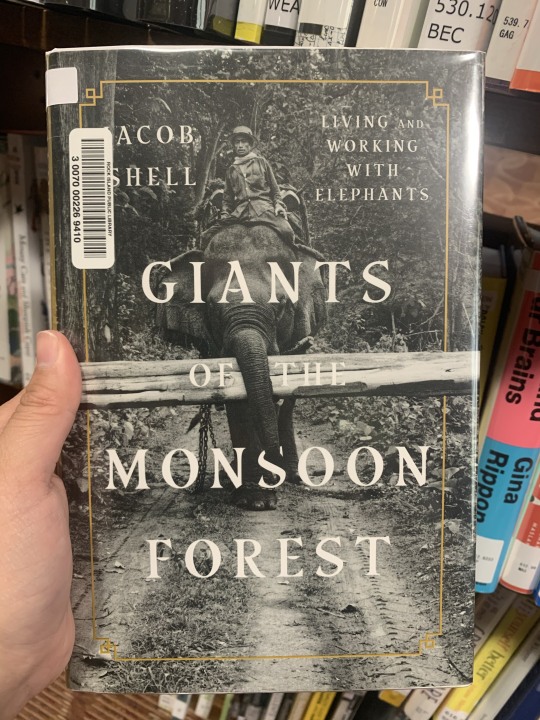
New non-fiction titles in the 500′s!
Summaries from Goodreads.com; Title link will bring you our local catalog
When the Earth Had Two Moons: Cannibal Planets, Dreadful Orbits, Icy Giants, Dirty Comets and the Origins of Today's Night Sky by Erik Asphaug
An astonishing exploration of planet formation and the origins of life by one of the world’s most innovative planetary geologists.
In 1959, the Soviet probe Luna 3 took the first photos of the far side of the moon. Even in their poor resolution, the images stunned scientists: the far side is an enormous mountainous expanse, not the vast lava-plains seen from Earth. Subsequent missions have confirmed this in much greater detail.
How could this be, and what might it tell us about our own place in the universe? As it turns out, quite a lot.
Fourteen billion years ago, the universe exploded into being, creating galaxies and stars. Planets formed out of the leftover dust and gas that coalesced into larger and larger bodies orbiting around each star. In a sort of heavenly survival of the fittest, planetary bodies smashed into each other until solar systems emerged. Curiously, instead of being relatively similar in terms of composition, the planets in our solar system, and the comets, asteroids, satellites and rings, are bewitchingly distinct. So, too, the halves of our moon.
In When the Earth Had Two Moons, esteemed planetary geologist Erik Asphaug takes us on an exhilarating tour through the farthest reaches of time and our galaxy to find out why. Beautifully written and provocatively argued, When the Earth Had Two Moons is not only a mind-blowing astronomical tour but a profound inquiry into the nature of life here—and billions of miles from home.
Mousy Cats and Sheepish Coyotes: The Science of Animal Personalities by John Shivik
In Mousy Cats and Sheepish Coyotes, Shivik serves as an accessible, humorous guide to the emerging body of research on animal personalities. Shivik accompanies researchers who are discovering that each wolf, bear, and coyote has an inherent tendency to favor either its aggressive nature or to shyly avoid conflicts. Some bluebirds are lovers, others are fighters. And some spiders prefer to be loners, while others are sociable. Unique personalities can be discovered in every corner of the animal kingdom--even among microscopic organisms. The array of personality types among all species is only beginning to be described and understood.
The Elements We Live By: How Iron Helps Us Breathe, Potassium Lets Us See, and Other Surprising Superpowers of the Periodic Table by Anja Røyne
An around-the-world journey to discover where in the wild we can find the elements of life and the surprising ways they’re essential to our survival.
We all know that we depend on elements for survival—from the oxygen in the air we breathe to the carbon that forms part of the structure of all living things. But how many of us appreciate the ways our bodies also depend on phosphorous, say, to hold our DNA together, or potassium to power our optic nerves so that we can see?
In The Human Elements, physicist and award-winning author Anja Røyne takes us on an astonishing journey through chemistry and physics, introducing the building blocks from which we humans—and the world—are made. Not only does Røyne explain why our bodies need iron, phosphorus, silicon, potassium, and many more elements in just the right amounts in order to function properly; she also takes us on a tour around the world to where these precious elements are found (some of them in ever-shrinking quantities).
Røyne makes us understand how precarious the balance that keeps us and our environment alive really is, how there are finite amounts of our life-giving elements available to us, and how, from the smallest to the grandest scale, the world and everything that lives in it are wonderfully interconnected. The Human Elements will make you look at the world and your place in it in an entirely new way.
Every Penguin in the World: A Quest to See Them All by Charles Bergman
A narrative and photographic book about the author's pursuit of penguins-to see each variety of the species in its natural habitat. This book tracks the author's forays around the southern hemisphere, from the Galapagos to South Africa to the Antarctic in his quest to see all the penguins in the world. The sections of the book are organized around themes of adventure, human-animal connection, and conservation-in which stories of each penguin species will be touched upon.
The Sakura Obsession: The Incredible Story of the Plant Hunter Who Saved Japan's Cherry Blossoms by Naoko Abe
The remarkable 1,200-year history of the Japanese cherry blossom tree--and how it was saved from extinction by an English gardener.
Collingwood "Cherry" Ingram first fell in love with the sakura, or cherry tree, when he visited Japan on his honeymoon in 1907. So taken with the plant, he brought back hundreds of cuttings with him to England, where he created a garden of cherry varieties. In 1926, he learned that the Great White Cherry had become extinct in Japan. Six years later, he buried a living cutting from his own collection in a potato and repatriated it via the Trans-Siberian Express. In the years that followed, Ingram sent more than 100 varieties of cherry tree to new homes around the globe, from Auckland to Washington. As much a history of the cherry blossom in Japan as it is the story of one remarkable man, the narrative follows the flower from its adoption as a national symbol in 794, through its use as an emblem of imperialism in the 1930s, to the present-day worldwide obsession with forecasting the exact moment of the trees' flowering.
Giants of the Monsoon Forest: Living and Working with Elephants by Jacob Shell
High in the mountainous rainforests of Burma and India grow some of the world’s last stands of mature, wild teak. For more than a thousand years, people here have worked with elephants to log these otherwise impassable forests and move people and goods (often illicitly) under cover of the forest canopy. In Giants of the Monsoon Forest, geographer Jacob Shell takes us deep into this strange elephant country to explore the lives of these extraordinarily intelligent creatures. The relationship between elephant and rider is an intimate one that lasts for many decades. When an elephant is young, he or she is paired with a rider, who is called a mahout. The two might work together their entire lives. Though not bred to work with humans, these elephants can lift and carry logs, save people from mudslides, break logjams in raging rivers, and navigate dense mountain forests with passengers on their backs. Visiting tiny logging villages and forest camps, Shell describes fascinating characters, both elephant and human—like a heroic elephant named Maggie who saves dozens of British and Burmese refugees during World War II, and an elephant named Pak Chan who sneaks away from the Ho Chi Minh Trail to mate with a partner in a passing herd. We encounter an eloquent colonel in a rebel army in Burma’s Kachin State, whose expertise is smuggling arms and valuable jade via elephant convoy, and several particularly smart elephants, including one who discovers, all on his own, how to use a wood branch as a kind of safety lock when lifting heavy teak logs. Giants of the Monsoon Forest offers a new perspective on animal intelligence and reveals an unexpected relationship between evolution in the natural world and political struggles in the human one. Shell examines why the complex tradition of working with elephants has endured with Asian elephants, but not with their counterparts in Africa. And he shows us how Asia’s secret forest culture might offer a way to save the elephants. By performing rescues after major floods—as they did in the wake of the 2004 Indian Ocean tsunami—and helping sustainably log Asian forests, humans and elephants working together can help protect the fragile spaces they both need to survive.
#science#science books#nonfiction#non fiction#non-fiction#reading recommendations#reading recs#book recs#Book Recommendations#currently reading#animals#elephants#sakura#space and time#astronomy#penguins#animal personalities#space
2 notes
·
View notes
Text
Arctic vs. Antarctic: how to pick your polar adventure
If you’ve ever dreamt about visiting one of the polar regions, use our guide to picking your Polar adventure: Arctic vs. Antarctic.
The North and South Poles were only “conquered” in relatively recent history. The South Pole was first set foot upon in 1911 by the Norwegian Roald Amundsen after his epic race with the ill-fated Scott. The conquest of the North Pole is a little murkier thanks to its location in the middle of the Arctic Ocean amid waters that are almost permanently covered with permanently shifting sea ice.
It’s possible that Frederick Cook was the first to reach the North Pole in 1908, or perhaps it was Robert Peary in 1911 or maybe Richard E. Byrd who was the first to fly over it in 1926… But it wasn’t until Roald Amundsen’s definitive flight over the Pole on 12th May 1926 that the first consistent, verified and scientifically convincing attainment of the North Pole was recorded.
Polar exploration has long sparked the public’s imagination and in recent years, travellers’ appetite for adventure means there is even more on offer than ever before.
Kia and I both dream of taking trips to the Polar circles – it’s just that we’re not sure when and where to go. (Well, that and the lack of funds…)
If you’ve ever dreamt about visiting one of these faraway destinations, use our guide to picking your Polar adventure: Arctic vs. Antarctic.
Temperature
Whether you head north or south you’re going to be cold. Very cold. However, it’s useful to know that unlike the rest of the planet, the south is colder than the north.
Broadly speaking, the Arctic region will experience temperatures between -43 and +5°C (-45 and 41°F) with coastal areas (which is where tourists are most likely to be) reaching +10°C (50°F) in the summer months. Average July temperatures range from about -10 to +10°C (14 to 50°F) with some inner land areas occasionally exceeding 30°C (86°F) in summer!
The Antarctic is a different story. It is the coldest continent on Earth. In 1983, researchers at the Soviet Antarctic station recorded the lowest natural temperature ever at ground level of -89.2°C (-128.6°F). Temperatures in Antarctica regularly reach -80°C (-112°F) in the interior in winter and between 5°C (41°F) and 15°C (59°F) near the coast in summer.
The Antarctic is considerably colder than the Arctic.
When to go
Winters and summers in the Polar regions are easier to define than in most destinations.
Put simply, the Arctic is closed from October to March thanks to much of the region being icebound, meaning ships cannot pass. The six-month darkness of the Polar night engulfs the region making sightseeing a rather tedious affair. Likewise, the Antarctic is closed from April to October due to freezing temperatures, the Polar night and pack ice reaching up to 1,000km beyond the edge of the continent.
Outside these timeframes, it largely depends on what you want to see and do and where exactly you want to go. For example, if you’re only interested in the bragging rights that come with crossing the Arctic Circle then this can be done year round in Scandinavia without leaving mainland Europe. At the other end of the world you’ll have to wait for the pack ice to break up between January and March to have a shot at crossing the Antarctic Circle.
The table below gives an idea of the best time to visit depending on your interests.
Best time for… Arctic Antarctic Largest icebergs Apr-Jun Nov-Jan Whales Apr-Sep Dec-Apr Humpback whales Apr-Jul – Narwhals Apr-Sep – Bird life Apr-Sep Dec-Mar Penguins – Dec-Feb Northwest passage accessible Jun-Aug – Ross Sea accessible – Jan-Feb Arctic circle crossing Year-round – Antarctic circle crossing – Jan-Mar North Pole expedition Feb-Apr – South Pole expedition – Nov-Jan Svalbard Jun-Aug – Greenland Apr-Sep – Falklands – Oct-Feb South Georgia – Oct-Jan Aurora watching Jan-Mar Mar-Sep
WildlifE
Even though the two Polar regions share many similar traits, they differ greatly in wildlife with a much wider range found in the north. This is because much of the landmass in the north is attached to continents that stretch further south while the Antarctic is completely isolated. This means the Arctic homes far more terrestrial mammals.
On land in the north you’ll find muskox, reindeer, caribou, foxes, hares, wolves, lemmings and of course, the polar bear. Marine mammals include seals, walruses, and several species of whale: humpback whales, baleen whales, narwhals, killer whales (orcas) and belugas.
youtube
In the south it’s slim pickings on land. The flightless midge, Belgica antarctica, is just 6mm (0.25in) in size and is the largest purely terrestrial animal in Antarctica. In the water there’s more to see with several species of penguin including Emperor, Adélie, Rockhopper, King, Chinstrap and Gentoo penguins all living in the Antarctic peninsular. Additionally, there are blue whales, killer whales, colossal squids and fur seals.
ADVENTURE
If you want to see how you measure up against the great Polar explorers of the past then here are a few of the best options available.
COMFORT
It’s unfair to call those unmoved by the above unadventurous – surely travelling to the Polar Regions is adventurous by definition. However, if you would prefer a little more comfort then there are plenty of cruise and activity holidays available which won’t leave your loved ones biting their nails until your safe return.
I have my eyes on the Arctic Circle Trail in Greenland as well as a trip to Tromsø in Norway to see the northern lights after our failed attempt to catch them in Iceland several years ago. Quark Expeditions offer a range of cruise-based holidays in the Polar regions.
The Arctic Circle Trail follows a course through an area known as the “land of one hundred lakes” (Image: Visit Greenland, Limited Commercial License)
Northern vs. Southern lights
One of the most stunning natural phenomena in the world are the Aurora Borealis and Aurora Australis, more commonly known as the Northern and Southern Lights. Unless you’re a Norwegian astronomer there really is little difference between the northern lights and the Southern Lights other than geographical location. They both take place over the Polar regions and are basically the same phenomenon.
That said, the northern lights are far more accessible. They can be viewed from Iceland, Finland, Norway, Sweden, Denmark, Scotland, Russia, Greenland, Canada and Alaska. Outside of continental Antarctica, the Southern Lights can only be seen from southernmost New Zealand, Argentina and Australia.
Culture
Arctic nations include Canada, Greenland (a territory of Denmark), Russia, United States (Alaska), Iceland, Norway, Sweden, and Finland. Within these nations, around four million people live within the Arctic Circle. Unlike the Antarctic, the Arctic has an indigenous population stretching back thousands of years.
The Inuit people inhabit the Arctic regions of Greenland, Canada, and Alaska, while other Circumpolar North indigenous peoples include the Buryat, Chukchi, Evenks, Inupiat, Khanty, Koryaks, Nenets, Sami, Yukaghir and Yupik. There are also industrialised cities within the Arctic Circle. The four largest communities within are in Russia and Norway: Murmansk (population 307,257), Norilsk (175,365), Tromsø (71,590) and Vorkuta (70,548).
Nenet woman among reindeer, Yamal Peninsula in Siberia © Lexi Novitske
In the Antarctic, there is no indigenous population. There are zero permanent inhabitants but there are numerous research stations set up across the continent. In the summer as many as 5,000 people reside in the Antarctic but this drops to around 1,000 in the winter. You won’t be visiting any craft markets here!
Cost
Simply put, Polar travel is expensive. You will be visiting the most inhospitable regions on the planet where life is hard. The Arctic Circle is far more popular due to its accessibility and the fact that travel is cheaper there. That said, some of the most expensive countries in the world (Norway, Sweden, Finland, Russia) are located along and within the Arctic Circle, making even the cheapest Polar weekend break an expensive affair.
The Antarctic is without doubt more expensive than its northern sibling. It is further away from transport hubs, there is no permanent accommodation available and life is simply harder further south. For an easy comparison of costs, a 13-day Arctic cruise and flight with Quark costs $7,995. In comparison, a similar 10-day Antarctic cruise and flight will set you back $11,595 – considerably more for considerably less.
Likewise, at the expedition end of the scale, Adventure Consultants’ North Pole – Ski the Last Degree trip (15-19 days) starts at $42,000 while the equivalent South Pole – Ski the Last Degree trip (15 days) costs $62,500.
Arctic vs. Antarctic
Polar travel like most forms of travel is on the rise. It is almost impossible to verify how many people visit the Arctic but during the 2009-2010 tourist season, over 37,000 people visited Antarctica – twice the estimated 14,000 that visited in the 1999-2000 season 10 years before. One assumes that this figure will continue to double every 10 years although I doubt (and hope) the Antarctic or the harder-to-reach areas of the Arctic will ever compete with Thailand or other popular destinations.
For me, the Antarctic is the very definition of adventure. The very mention of its name evokes tales of against-the-odds survival and iconic names such as Amundsen, Shackleton and Scott. I dream of completing the seven summits which means that one day I will have to climb Vinson Massif in Antarctica – an ambition I look forward to with both boyish enthusiasm and wary trepidation.
The South Pole was first set foot upon in 1911 by the Norwegion Roald Amundsen
Kia and I were in Tierra del Fuego last year but at the wrong time for a trip to Earth’s southernmost continent. We will just have to go back one day…
Maybe it’s because we live in Europe but the Arctic simply doesn’t have the same allure as the Antarctic. Sure, we want to visit Greenland, trek the Arctic Circle Trail, see the northern lights and cross the Arctic Circle. But considering many of these are just a (relatively) short plane ride away, it just doesn’t have the same end-of-the-Earth appeal.
For me, the Antarctic still grabs all the headlines.
G Adventures are the largest small-group adventure travel company in the world with over 650 small group adventures to choose from and offer a range of Antarctica cruises.
(function(d, s, id) var js, fjs = d.getElementsByTagName(s)[0]; if (d.getElementById(id)) return; js = d.createElement(s); js.id = id; js.src = "http://connect.facebook.net/en_US/sdk.js#xfbml=1&appId=696667793712621&version=v2.3"; fjs.parentNode.insertBefore(js, fjs); (document, 'script', 'facebook-jssdk'));
from Cheapr Travels https://ift.tt/2J7i5JW via https://ift.tt/2NIqXKN
5 notes
·
View notes
Text
A Whale of a Day
Over night we sailed deeper into the Weddell Sea and today we are at Snow Hill Island.
The Swedish exploring ship Antarctic traveled to these waters in 1902. They left a six-man scientific team on Snow Hill Island. The ship then headed toward South America where it planned to wait out the winter before returning to pick up the scientists. However, on the return trip, there was still too much ice in the Weddell Sea to reach Snow Hill Island. The ship’s captain left three men in Hope Bay, ordering them to walk 65 miles over the ice to inform the scientists on Snow Hill that the ship would be delayed. But, the ice was melting on their route and the three men, unable to reach the scientists, retreated to Hope Bay. Meanwhile, the ship was trapped by ice as it traveled south and eventually sank. The crew on board passed the winter in a hastily constructed shelter on Pawlet Island, which we visited yesterday. A year later, the Argentine ship, Uruguay (the museum ship we visited in BA) arrived to rescue the crew of the Antarctic. The Uruguay came to Snow Hill Island as they knew the scientists had planned to spend a year there, a year that had now stretched into two. They found the scientists as well as the three men who had been dropped in Hope Bay, who had eventually made their way to Snow Hill during the intervening year. The rescue team had given the rest of the ship crew up for lost and were about to set sail, when the crew appeared over the hill on Snow Hill in time to also be rescued. ….that was a close call. They had walked over the ice from Paulet Island to Snow Hill Island. Of the entire crew of the Antarctic, only one man died, and he died of heart failure. The others returned to Argentina for a hero’s welcome.
Through the afternoon, we sailed further south. The captain intentionally drove the ship into a huge area of sea ice, which stopped it cold. We all disembarked and spent a lovely few hours out on the ice. It was amazing to think that we were “walking” on seawater and that the entire sea is hard with similar ice for most of the year. Our ice party ended with a barbeque out on the ship’s sun deck….where there was very little sun but a good party!
At 6pm, a huge blue whale joined us on our route. It swam directly in front of our ship for almost 30 minutes. The blue whale is the largest of the whales and the largest animal on earth. It is up to 100 feet long. It playfully rolled in front of us, showing off its huge size and beautiful fin. I have neither the skill nor the equipment to photograph whales, so no pictures of this guy.
But as perfect as that was, it got better. Just after dinner, the captain announced that he had spotted a pod of killer whales. Killer whales are actually dolphins and act like dolphins, travelling in a family group . When we got out on deck, we spotted not only the orcas, but a blue whale, ten or more fin whales and a few humpbacks. Where ever one turned, there was another whale either spouting, fluking or surfacing. It was amazing. Again, no photos.
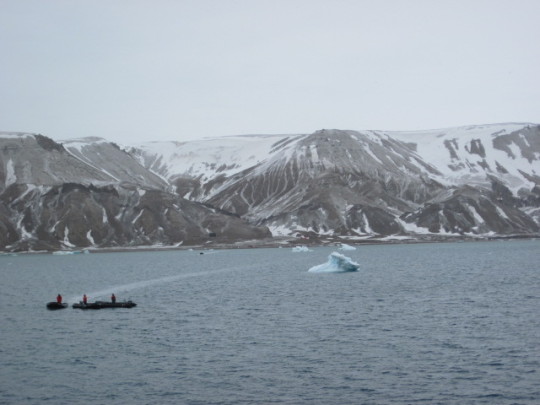
Snow Hill Island in the Weddell Sea.
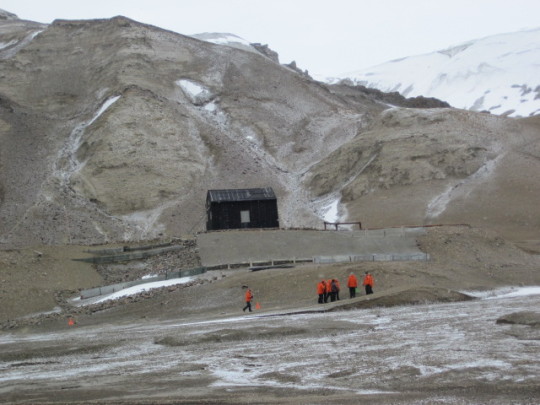
Landing on Snow Hill Island
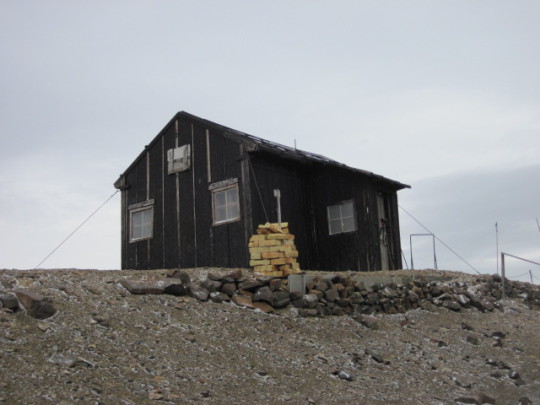
The Nordeskjold team of scientists brought this hut, prefabricated with them to the island as they planned to winter over. They came very well prepared. In addition to the hut they had a stove and supplies, dogs, all they needed for a year. It got a little tricky as the year unexpectedly turned into more than two years.

The inside of the hut has been maintained just as it was left in 1903.
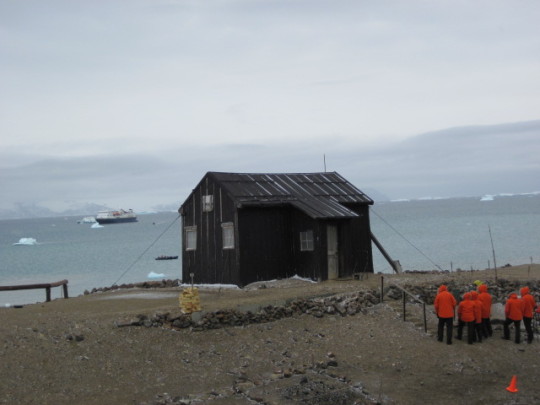
It is quite a spot but I would not want to live with five friends here for two years.

.
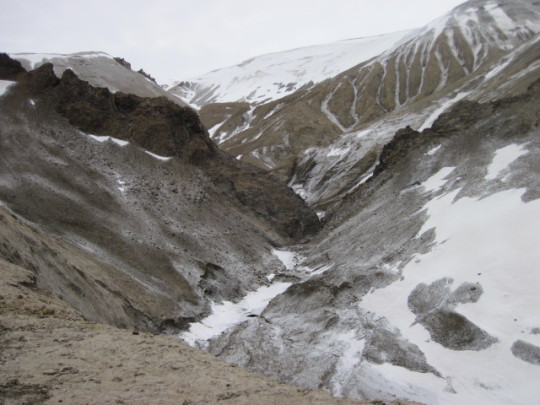
Looking inland from behind the hut.
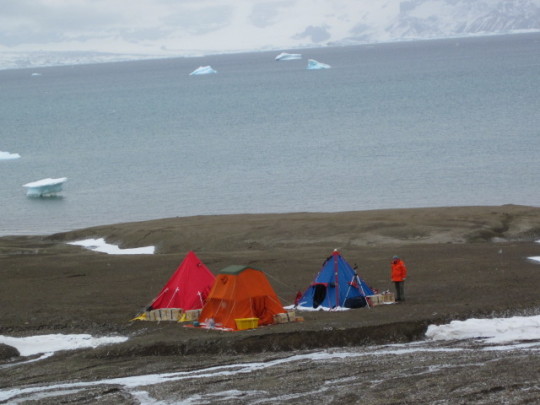
A group of Argentines had arrived the day before and set up camp. They will spend three weeks on the island doing maintenance to the hut and surrounding property.

Sailing through the Weddell Sea.
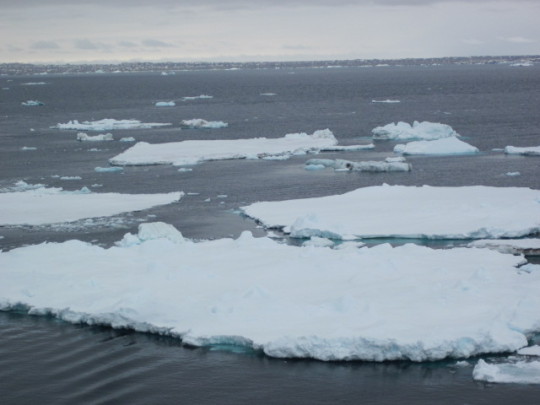
The Weddell is full of ice. It’s summer so the ice is broken up, but in winter it is a solid sheet.
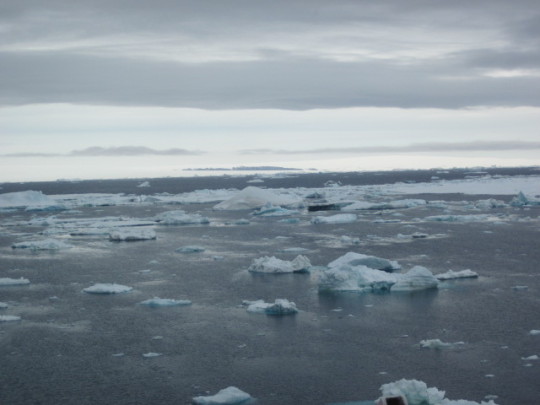
.
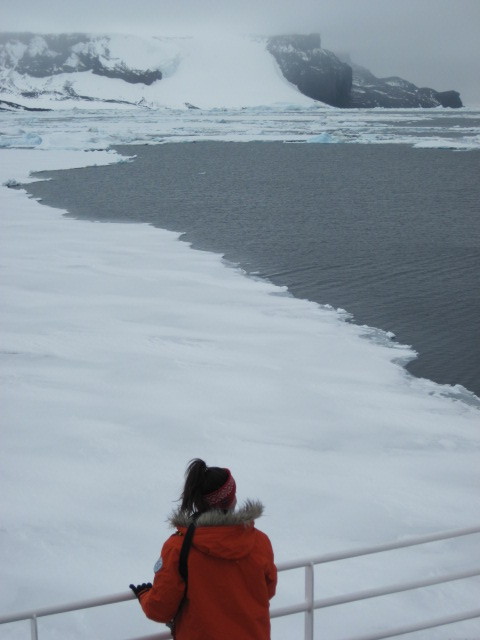
We were approaching a huge ice sheet.
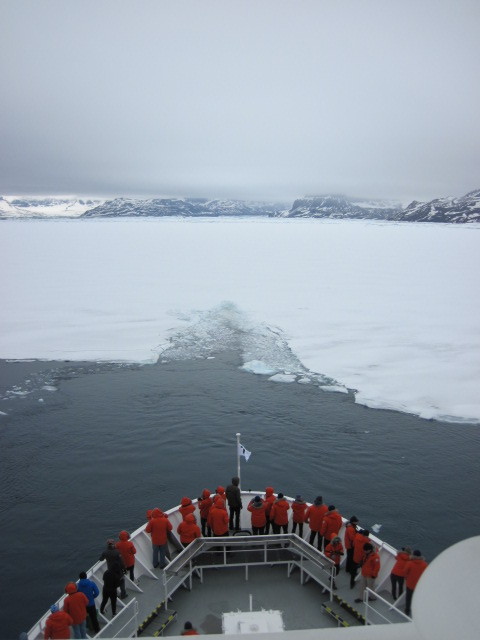
The captain slammed into the ice, then backed off and did it again. We were well parked when he finally turned off the engines.

The captain expected us to walk down the gangplank to the ice. But, there was a big crack where the gangplank touched down, so he decided it was safer for us to take the zodiacs about 10 yards and then climb onto the ice.

We all fanned out across the ice sheet.

They made us wear life jackets, but luckily no one needed to be rescued.
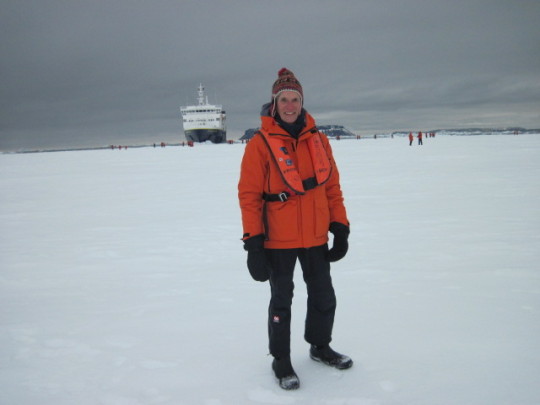
.
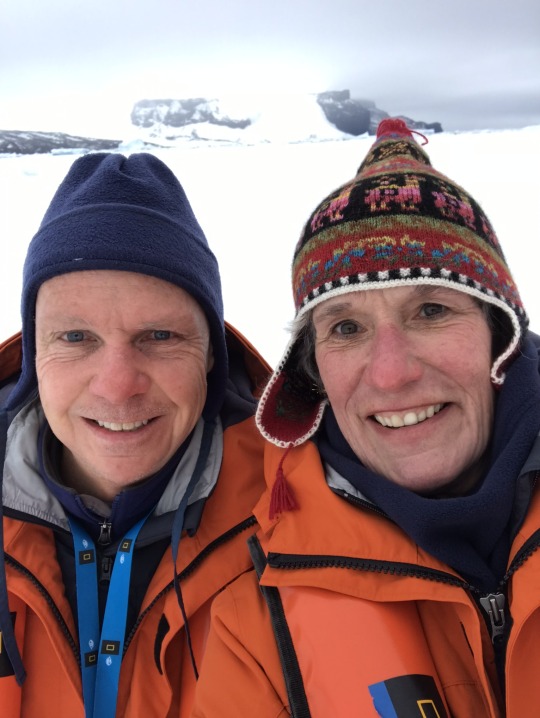
The mandatory selfie!
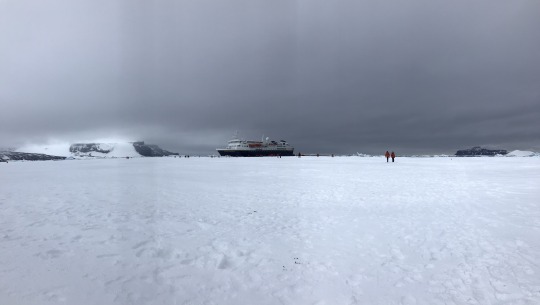
This is a panorama of the whole ice flow. It looks great on my camera!
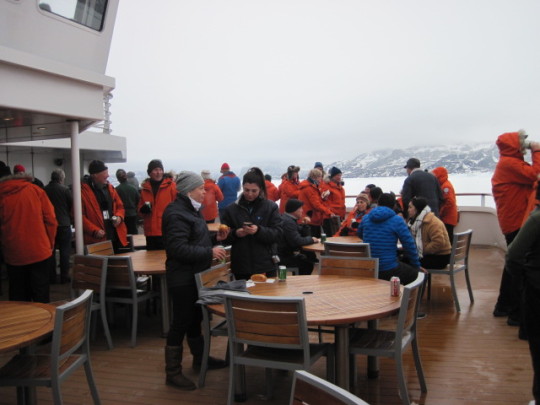
A chilly barbecue on a not very sunny sun deck to celebrate our “ice walk”
2 notes
·
View notes
Text
10 Interesting Fiction Books
Curfew by Jose Donoso
“Donoso’s engrossing novel spans 24 hours in the stifling and oppressive political atmosphere of 1985 Santiago under General Augusto Pinochet’s military regime.
A leftwing singer returns after 13 years of exile in Paris. His fame now faded and his politics softened, Mañungo Vera is no longer the revolutionary he once was. His visit coincides with the death of Matilde Neruda, widow of the Nobel prize-winning poet and icon of the Chilean left, Pablo Neruda.
Vera is reacquainted with old friends and comrades as they prepare for the funeral. But, caught out by the curfew, he is forced to spend an eventful night on the streets with his former lover, during which they have a dangerous run-in with her suspected torturer.
Donoso paints a harrowing picture of life under the repressive regime, and shows how negotiating its daily horrors damages both individuals and society. He also shines a harsh light on the left, as factions squabble and jockey for advantage from the funeral.
This intense, introspective tale reflects the political and spiritual decay of the nation, after more than a decade of dictatorship.” (Khaneka, P. 2015, April 9. The best books on Chile: start your reading here. 2020, September 27.)
The House of the Spirits by Isabel Allende
“Allende’s classic, hugely successful family saga is a masterwork of magic-realism. Fusing the personal with the political and fact with fantasy, it tells Chile’s recent history through several generations of the Trueba family, ending with a savage military coup that leads to the death of a president.
The principal protagonist, Esteban Trueba, is used to getting his own way – in his family (as an irascible patriarch), on his farm (as a wealthy landowner), and in the country (as a rightwing senator): “The day we can’t get our hands on the ballot boxes before the vote is counted, we’re done for.”
When a socialist candidate finally wins the presidential election, Trueba backs a coup. But in the ferocious denouement that follows, he finds himself sidelined as brutality and terror spiral under the newly installed military regime.
The novel celebrates the spirit and resilience of the Trueba women, which shine through the political tumult and family turbulence in this clever, witty and stunningly assured debut.
Allende’s father was a cousin of President Salvador Allende, who was overthrown and died during a military coup in 1973. In 1975, the author fled to Venezuela, and later moved to the US. She has said the book is an “attempt to recreate the country I had lost, the family I had lost”. (Khaneka, P. 2015, April 9. The best books on Chile: start your reading here. 2020, September 27.)
Daughter of Fortune by Isabel Allende
“Orphaned at birth, Eliza Sommers is raised in the British colony of Valparaíso, Chile, by the well-intentioned Victorian spinster Miss Rose and her more rigid brother Jeremy. Just as she meets and falls in love with the wildly inappropriate Joaquín Andieta, a lowly clerk who works for Jeremy, gold is discovered in the hills of northern California. By 1849, Chileans of every stripe have fallen prey to feverish dreams of wealth. Joaquín takes off for San Francisco to seek his fortune, and Eliza, pregnant with his child, decides to follow him.
As Eliza embarks on her perilous journey north in the hold of a ship and arrives in the rough-and-tumble world of San Francisco, she must navigate a society dominated by greedy men. But Eliza soon catches on with the help of her natural spirit and a good friend, the Chinese doctor Tao Chi’en. What began as a search for love ends up as the conquest of personal freedom.
A marvel of storytelling, Daughter of Fortune confirms once again Isabel Allende's extraordinary gift for fiction and her place as one of the world's leading writers” (Amazon)
The Savage Detective by Roberto Bolano
“In this dazzling novel, the book that established his international reputation, Roberto Bolaño tells the story of two modern-day Quixotes--the last survivors of an underground literary movement, perhaps of literature itself--on a tragicomic quest through a darkening, entropic universe: our own. The Savage Detectives is an exuberant, raunchy, wildly inventive, and ambitious novel from one of the greatest Latin American authors of our age.” (Amazon)
By Night in Chile by Roberto Bolano
“As through a crack in the wall, By Night in Chile's single night-long rant provides a terrifying, clandestine view of the strange bedfellows of Church and State in Chile. This wild, eerily compact novel―Roberto Bolano's first work available in English―recounts the tale of a poor boy who wanted to be a poet, but ends up a half-hearted Jesuit priest and a conservative literary critic, a sort of lap dog to the rich and powerful cultural elite, in whose villas he encounters Pablo Neruda and Ernst Junger. Father Urrutia is offered a tour of Europe by agents of Opus Dei (to study "the disintegration of the churches," a journey into realms of the surreal); and ensnared by this plum, he is next assigned―after the destruction of Allende―the secret, never-to-be-disclosed job of teaching Pinochet, at night, all about Marxism, so the junta generals can know their enemy. Soon, searingly, his memories go from bad to worse. Heart-stopping and hypnotic, By Night in Chile marks the American debut of an astonishing writer.” (Amazon)
Distant Star by Roberto Bolano
“The narrator saw that man for the first time in 1971 or 1972, when Allende was still President of Chile. He wrote distant and cautious poems, seduced women, and aroused indefinable mistrust in men. He saw him again after the coup, but at the time he was unaware that this aviator, who wrote Bible verses with the smoke of a WWII plane, and the poet were one, and the same. And so we are told the story of an impostor, of a man of many names, with no other moral than aesthetics, dandy of horror, murderer and photographer of fear, a barbarian artist who took his creations to their last and lethal consequences.” (Amazon)
Ways of Going Home by Alejandro Zambra
“Alejandro Zambra's Ways of Going Home begins with an earthquake, seen through the eyes of an unnamed nine-year-old boy who lives in an undistinguished middle-class housing development in a suburb of Santiago, Chile. When the neighbors camp out overnight, the protagonist gets his first glimpse of Claudia, an older girl who asks him to spy on her uncle Raúl. In the second section, the protagonist is the writer of the story begun in the first section. His father is a man of few words who claims to be apolitical but who quietly sympathized―to what degree, the author isn't sure―with the Pinochet regime. His reflections on the progress of the novel and on his own life―which is strikingly similar to the life of his novel's protagonist―expose the raw suture of fiction and reality.” (Amazon)
The Shadow of What We Were by Luis Sepulveda
“Sepulveda packs more than three decades of Chilean history into this lean and darkly humorous novel. Three aging revolutionaries-Cacho Salinas, Lolo Garmendia, and Lucho Arancibia-reunite to pull off one final, spectacular heist, gathering in a hideout to await the arrival of the Shadow, a legendary Robin Hood-type anarchist. As the comrades with their graying beards, thinning hair, and chubby physiques wait, they revisit the past and ruminate on losses: after Pinochet's coup, Cacho and Lolo fled to Europe, while Lucho, whose brothers were murdered by the regime, stayed and endured torture that has left him brain damaged. Meanwhile, and unbeknownst to the trio, the Shadow lies dead on the sidewalk, struck down by a freak accident. Although the narrator frequently runs away with the story, trailing off into history lessons, Sepulveda maintains a high level of suspense as the police investigate the Shadow's death, and Cacho, Lolo, and Lucho decide whether to go through with their plan, turning their collective sorrows into a celebration of the resilience of the human spirit. (Feb.) (c) Copyright PWxyz, LLC. All rights reserved." (Amazon)
Tengo Miedo Torero by Pedro Lemebel
“This is a love story in Santiago de Chile in 86, the year of the Pinochet attack. A boy from the Manuel Rodriguez Patriotic Front, who is going to participate in the action, lives a sentimental relationship with a gay man who supports him, without knowing-knowing it, in his political plans. But they fail and their relationship ends as well. I am afraid of a bullfighter is the verse of a song that Sara Montiel used to perform. His words suggest, beyond theatricality and melancholy, the recondite interiority of a country that, as defined by the author, sounds very little, it sounds like credit, it does not sound the impossible.” (Amazon)
Frozen in Time: Murder at the Bottom of the World by Theodore Jerome Cohen
“The trail from a major theft at the Banco Central de Chile in Talcahuano following the Great Chilean Earthquake of May 22, 1960 leads to Base Bernardo O'Higgins, a wind- and snow-swept Chilean Army outpost on the North Antarctic Peninsula. When Chilean Army 1SGT Leonardo Rodríguez fails to return from a seal hunt in the waters around the base, two Chilean Navy non-commissioned officers, CWO Raul Lucero and CPO Eduardo Osorio, become LCDR Cristian Barbudo's prime theft and murder suspects. Fearing he will die, Barbudo reveals the identity of his two suspects to visiting scientist Ted Stone, thereby placing Stone's life in jeopardy. But who can Stone trust with this information, if it comes to that, to see justice done? This story is a work of fiction based on real events that took place between 1958 and 1965. It is a tale of greed, betrayal, and murder-one in which the reader is given a window into the frozen world at the bottom of the Earth that few people ever will read about, much less experience. Among other things, it explores why, though seemingly unfair, bad things happen to good people; how the battle between good and evil can change forever even the most innocent person; and most of all, the role deception plays in Nature, Man, and Life.” (Amazon)
0 notes
Photo

New Post has been published on https://ourbigescape.com/7673-2/
NewZealandDMCA
Welcome to the Ultimate New Zealand Travel Guide! Some may say that the Lord of the Rings movie franchise really helped to put New Zealand on the map (a common joke among Kiwi’s is how often maps of the world miss their country out…), but the truth is that it simply made this amazing country much more accessible. Nobody would doubt that visitor levels have hugely increased over the last twenty years or so, but don’t for a second assume that you will feel crowded anywhere on these islands.
While the country is famed for its stunning natural beauty – you could easily spend four weeks touring the South Island alone – there is plenty more of interest to entertain visitors looking for a more varied experience. From exploring Maori culture, through to roaming the enormous national parks, taking in some rugby, sipping on some world-class wines, through to enjoying some manuka honey on your breakfast toast, there is plenty to keep you busy during your time in New Zealand.
The Ultimate New Zealand Travel Guide recommends this country not just to those who love to get outside and active (although those into extreme sports will arguably find no better country), but those with an interest in culture, wildlife and especially photography. Why not take in a cruise or organized New Zealand tour if you have less time at hand? Or if time is of no object, perhaps tour leisurely at your own pace – this country is outstanding for camping and living on the cheap if you are careful.
Top Places To Visit In New Zealand
Despite being – in strictly geographical terms – in the middle of nowhere, New Zealand is just as accessible as anywhere else on the planet that may involve a slightly longer than usual flight. Given the fact that many visitors will have traveled the best part of halfway around the globe to get there, it is perhaps reasonable to allow for at least a couple of weeks in the country – and ideally another one or two on top if time allows. That sort of timescale will allow plenty of time to visit and explore both the North and South Island.
Instead of comparing which island is ‘better’ (we dislike that word) you should understand the differences and figure out whether you wish to spend more time in one than the other, or split your time equally. Contrary to what you may have assumed both islands are gorgeous. The North tends to have a warmer climate, sandier beaches, more spectacular coastline, geothermal spots and is generally more accessible from major cities/towns. On the other hand, the South Island is considerably larger, has more of those epic peaks and fjords that feature so heavily in LOTR, stunning waterways (that are handy for getting about), and no shortage of Maori spots well worth visiting (plenty of those on the North Island too).
Many people will arrive in Auckland and it is worth spending a few days exploring the city and its nearby sights. Auckland is surprisingly cosmopolitan and in some ways, it feels quite strange to have a modern, vibrant city in a country that is otherwise so calm and placid. Expect all the comforts and conveniences that you would find anywhere else, and perhaps use it as a base/launching pad for exploring key sites such as the Hauraki Gulf, the Bay of Plenty, Waikiki, Rangitoto Island (amazing!) and in classic NZ fashion take a bungee jump from the Sky Tower! Head further inland and you’ll stumble upon Rotorua and the famous Te Puia volcanic geysers and springs. Wellington is also well worth a visit for a slightly more sedate city experience. Be sure to check out the Ecosanctuary and botanical gardens for a taste of how truly progressive this country tends to be.
The Southern Island is dominated – in urban terms at least – by Christchurch and Dunedin. Both are known for their colonial heritage and have quite bizarre similarities to smart British provincial towns. Make absolutely certain to check out the International Antarctic Center, Canterbury Museum for local and indigenous history, and relax in the very smart and elegant North Hagley Park. Dunedin is a fascinating place that not only feels British but even looks like a Scottish town snuggles within the spectacular surrounding scenery. Larnach Castle is a classic Victorian stately home that is well worth squeezing into your itinerary, but the real highlight has to be the scenic railways. Be sure to head out to the Otago Peninsular if you like penguin watching, and the Tunnel Beach area offers some truly spectacular ‘edge of the world’ scenery.
But let’s face it – most people head to the South Island for the wilderness, glaciers, and adventure sports mecca of Queenstown. Do not underestimate the size of this island and simply accept the fact that you will be tempted to stop for photos pretty much every couple of miles before realizing that the whole place is stunningly beautiful! Picking out the best spots could really result in alist running into the hundreds, but we’d recommend you head to Abel Tasman National Park up in the north, Marlborough Sounds, and certainly Milford Sound. Allow for a few days around the sound especially if you are planning on hiking or even scaling some of the spectacular mountains.
We’ll discuss the practicalities of exploring the country later in the Ultimate New Zealand Travel Guide, but for now, just take the time to understand that while NZ looks quite small on the map it is anything but that once you are in the country itself. You will really kick yourself if you only visit for a week and try to cram in as much as possible, simply because you are going to have to miss huge chunks of the country in such a limited timeframe. Two weeks ought to be the minimum and that allows for only three or maybe four days to devote to the cities/towns. Three weeks is much more reasonable (one in the North, two in the South) if you wish to take in the key sights, especially if you take the plunge on arranging your own private transport.
Things To Do In New Zealand
We’ll begin this section with a rather bold statement. You simply will not find a better country for photography than New Zealand. We’d honestly recommend that those who have always been interested in learning photography take a few classes/courses before they visit this country. The scenery, colors, contrasts and sheer magnificence are going to enchant you. Best of all, you can snap away literally anywhere you head in the country. Need some action shots? Check out the wildlife, Maori sites, city buzz, and the crashing coastlines. Like your landscapes and portraiture? Just take your pick of pretty much anywhere else! We say this specifically for photographers but all visual artists will find some aspects of New Zealand to enjoy sketching, painting or perhaps even writing about. It is no less than a creative person’s dream landscape.
But what if you would prefer to enjoy some death-defying stunts instead! Well, New Zealand ranks as one of the best places on the planet for outdoor sports. From mountaineering through to rafting, biking, caving, hand gliding, bungee jumping, and pretty much everything else you simply cannot help but be tempted to get the adrenalin racing. The New Zealand national obsession with extreme sports is a little bit of a national stereotype and a butt of many jokes (mostly from ‘nearby’ Australians!). We’d recommend that anyone interested in doing these activities with safety in mind takes on the services of one of the many top-quality agencies/guide companies who will provide equipment and training as required.
Road trips are an excellent way of getting out and exploring New Zealand and we’d highly recommend active people consider the more environmentally sound (and far cheaper!) option of taking on a bike tour of the country. Cycling through NZ is really easy and safe with mild temperatures for large parts of the year and long stretches of almost empty roads. Camping rules vary depending on the region but you can generally pitch up in most places, or make use of the superb facilities you’ll find throughout the national network of campsites. Providing you are not in a rush then this is a country that really lends itself towards visitors who like to set their own agendas and itineraries.
Take the time to appreciate the Maori culture wherever you head in New Zealand and make the effort to explore the less traveled – and often surprisingly more interesting – spots too. You’ll find Maori culture throughout the country – we recommend reading up on the basic history and facts before arriving to help comprehend and appreciate the wonderful sights in their appropriate context. Ever wanted to learn the Haka dance, made world-famous by the national rugby team (the ‘All Backs’)? Then do so, and try out some of the trickier routines as well. Make sure you don’t fall over…
Anyone who likes to appreciate wildlife in its natural and undisturbed habitat should find New Zealand one of the most incredible places they will ever have visited. You can swim with dolphins all over the place, but how about taking a dip with the seals along the South Island coast? Kiwi spotting is a lesser stated national obsession, and those in the mood for the absolutely spectacular should check out the options for whale watching too. There is no shortage of excellent quality organized tours that help visitors to responsibly enjoy the natural beauty of New Zealand, and we recommend looking in this direction to help reduce the environmental footprint. Most of the best are run by charities and conservation teams, although you’ll find that all are licensed and minded in this direction.
Best Time To Visit New Zealand
New Zealand is busiest over the peak summer months which runs over December and February. Depending on the weather it could stretch for a couple of weeks either way, but this is when the country tends to be busiest. Expect the popular beaches and sites to be reasonably busy (although nothing like as crowded as other popular countries), but good quality/value accommodation books out fast and well in advance so be on your toes to secure any good deals.
Match through to early May is also a good time to visit. Temperatures will be a little cooler but you’ll have far fewer people sharing the views with you. The discounted accommodation market is not quite as strong in NZ as compared to other destinations but prices should be a little more reasonable. Snow will perhaps be falling in some parts so it can be good for taking in some early season deals.
Anywhere between June and late November tends to be low season for anything apart from snow sports. You will have your pick of any restaurant and hotel away from the main skiing destinations where prices will go through the roof! If you like to explore the scenery in near isolation and remember to pack some warm and waterproof clothing this is also a great time to visit. As with above, discounts may appear here and there but plenty of hotels just semi-close during these months with reduced occupancy at regular prices.
GOVERNMENT LINKS General Information VISAS History, Culture, and Events
Tourist Visa In New Zealand
New Zealand is fiercely protective of its natural splendors and has a long list of prohibited items both material and organic, so check these out before you start packing your bags. For your convenience: https://www.mpi.govt.nz/travel-and-recreation/arriving-in-new-zealand/items-to-declare/
Make sure that all your camping and hiking gear (especially boots) are spotless.
New Zealand operates a pre-arrival screening process which means that once you arrive in the country passing through customs ought to be a breeze.
Nationals of over 60 countries do not require a visa to visit New Zealand for up to 90 consecutive days. These include the USA and alongside most EU nations. These passport holders are allowed to stay for up to sixty consecutive days.
People from other Commonwealth countries (UK, Australia, Canada, etc) are allowed to stay for longer. UK nationals can stay for six months, while Australians can usually remain for as long as they please.
The visa system for longer stays or employment is quite complicated and varies considerably between countries. Generally speaking and in the experience of the Ultimate New Zealand Travel Guide, NZ is pretty relaxed about allowing people to stay longer providing they arrange to do so in advance and can prove they are able to sustain themselves. Don’t take our word for a rule, but anyone with a good reason for staying longer (and maybe even working) should be able to make arrangements providing they follow the basic application structure to the letter.
NZ is, overall, pretty chilled out when it comes to letting people visit and stay awhile. It is one of the reasons we like it so much!
Currency In New Zealand
New Zealand uses the New Zealand Dollar (NZD) that at the time of writing trades for around NZD 1.6 = USD 1.
You will have absolutely no problems handling your finances while in the country. Banks offer good value currency exchange rates, and ATMs are found everywhere there are people! Keep an eye on the possible charges and the conversion rates offered by your own bank. Some may have reciprocal arrangements with NZ banks and offer considerably lower rates. You will require a local bank account if you are intending on working in the country and these can usually be arranged in advance.
Credit cards/debit cards are accepted almost everywhere and you ought to use these for the majority of your purchases. Do not expect to hire a car without a credit card.
Very broadly speaking the largest single expense that most people will encounter with visiting NZ is their flight tickets. While the country is not exactly cheap, you can certainly stay for a long while on a modest budget providing you are careful with managing your money. Costs of accommodation, food, and travel are very similar to those you’d expect to find in western Europe and we’d say a little bit cheaper compared to Australia.
Tipping In New Zealand
You’ll notice quite a few similarities with New Zealand and the UK & Australia. Tipping policy/attitudes are a good example of this. While there is not much of a tipping ‘culture’ and it is certainly not mandatory, a modest tip should be left for table service or exceptional levels of service in other contexts. 10% is about right in most cases.
In cafes, bars, and taxis you may wish to sometimes round up the change a little to leave a token gratuity. For instance, leave the change on a $20 cab fare if it comes to $18.50, or say ‘just give us five back’ on a $14 fare when you pay with a twenty. Tipping is causal and not a big deal in New Zealand compared to many other countries.
Budget For Traveling New Zealand
Providing you take care to plan your finances with a degree of care before you visit New Zealand you may well be surprised at how reasonably affordable it can be. Budget visitors will need to make use of the generally excellent hostels and campsites to keep their outgoings sensible but can get about and live reasonably well without burning through their cash too quickly. Those wishing to stay in hotels and enjoy greater financial flexibility can find plenty of ways to spend their money throughout the country, with the added plus that it is difficult to actually ‘waste’ cash in this country. Look for value, check reviews, and book a little ahead and you will likely be dazzled at how great services catering for the tourist economy can be.
Here are some rough guidelines that the Ultimate New Zealand Travel Guide would suggest for visitors across three budget tiers. All prices are in NZD.
Budget ($100/day)
Before we begin it should be noted that you could quite realistically go for entire days in NZ without needing to spend a single dollar. That is assuming you are camping, have paid for your spots already, and have a few days of nonperishable groceries to sustain you. So take that daily threshold with a good pinch of salt as how much you need to spend in this country really depends on what you want to see and where you happen to find yourself.
Travel throughout New Zealand is pretty reasonable and we’ll cover this later. Just make sure to use appropriate and applicable discounts where you can, book in advance (we really cannot stress this enough!) and time your visit according to what you want to focus upon. Peak season exploration is perfectly plausible on a modest budget providing you are happy to ‘rough it’ a little and look after yourself.
It is worth mentioning that plenty of people who opt to spend a good while in the country – perhaps 6-12 months or so – tend to work in the ski resorts during the season, save up some money, and spend their earnings touring the country during the summertime. Consider this if it matches your profile and you fancy taking on a real New Zealand adventure.
Mid-Level ($200/day)
Decent enough hotel rooms will cost around half your daily budget – so make that a quarter assuming you are sharing a double or twin room. You ought to be able to live pretty well on this budget, including two or maybe even three meals out per day, all the travel you could wish for (including flights between the islands), most general excursions besides the very specialist options, and still have a little money left over.
We’d suggest seriously looking into hiring a car especially if you are sharing as part of a group (this advice also applies to our budget travelers too). Vehicle hire is easily available in the country and you should find a decent four/five-seater for between $50-70/day. NZ roads are excellent and you should not require high performance or four-wheel drive options unless really heading out into the sticks during snow season.
With this kind of budget, you should really be able to enjoy New Zealand exactly how you wish. If you have the time it is worth taking elements of this budget (occasional comfy hotels, car hire, restaurant meals) and combining it with some camping and hiking to not only balance out your expenditure towards a longer time but also to enjoy different aspects and experiences. Nobody visits NZ for the quality of the hotel rooms…
High-End ($300+/day)
You will honestly struggle to spend over $200/night in most hotels besides the ultra-exclusive boutique options in Auckland and the ski lodge areas. Whether or not you really need deluxe accommodation is up to you (or your bank manager) – but we’d suggest pooling that excess and pushing towards some ‘once in a lifetime kind’ of experiences instead. You really do not need to spend more than $60-90 in the most exclusive restaurants unless you hit the wine list hard. Prices can then become silly quite quickly…
There are a vast number of organized tours you could opt for here, and we’d strongly suggest you look towards the kind of multiple destination whale watching cruises which run daily costs of about this sort of price range. Balloon trips (always a favorite of the Ultimate New Zealand Travel Guide team) are staggeringly good and available at most of the popular sights.
Perhaps look into more ecologically minded tourism with this kind of budget. You won’t find much in the way of high-end shopping – at least not anywhere offering close to reasonable prices – so why not spend that cash on something a little more rewarding instead?
These very approximate guidelines should hopefully indicate that once you are in NZ you really do not have to spend a crazy amount of money to get by and explore in decent comfort. Groceries are a little steeper than you may anticipate but otherwise, costs are pretty reasonable when you factor in that much of the country’s products need to be imported. Give some good thought towards how you wish to enjoy your time in the country, and we’d highly recommend living closer to a shoestring budget if it allows for a longer and more varied stay.
Language In New Zealand
Everyone speaks English as either a first or second language and you will have no problems communicating with anyone during your stay. Maori is an official language (3.7% speak it as a first), and you will have very small communities which may opt to speak in one of the Polynesian languages, Hindu, or French.
Religion In New Zealand
Despite their love for reckless sports, New Zealand has always had something of a more conservative reputation that many people assume could be linked to a greater rate of religious observance compared to similar countries. If anything, the opposite is actually the case. New Zealand is not an especially religious country in the slightest, and almost half of the country claim to have no religious beliefs whatsoever.
Christianity – in various denominations – would represent the largest overall religious group with very small pockets of Hindusim, Islam, Buddhism, and others. You will have no trouble finding a place to participate anywhere in New Zealand, but you’ll find that most people aren’t especially bothered either way.
Practical Tips For New Zealand Travelers
New Zealand has a vast amount to offer visitors and it is no surprise that the country has been one of the most desirable to experience in recent years. There is no shortage of ways to see the country in whatever manner best suits your travel style, and it is actually one of those countries that you can’t easily pigeonhole. It certainly shares some characteristics with Australia, in the sense that it rewards visitors who explore under their own steam and take their time wherever possible to appreciate its natural wonders. While the cities have plenty of interest you’ll not travel thousands of miles for them alone – which in many ways tends to remind us of Scandanavia. We’ll let you make up your own mind about New Zealand because if you have the opportunity to visit you really would be crazy not to do so!
At this stage, the Ultimate New Zealand Travel Guide is going to take a closer look at some of the practicalities involved in visiting New Zealand. Despite being literally on the other side of the planet, you’ll find that the country shares quite a number of close similarities with Britain – perhaps hardly surprising given their long and intertwined histories. It is certainly more ‘British’ (and we use that definition as opaquely as possible) than Austalia and Canada, with a fondness for cricket, rugby, tea, queuing, and so forth – but do not be fooled into thinking this is anything like a remote English county. New Zealanders are very proud of themselves and their islands – but tend to not really shout about how amazingly good their country happens to be. They’re far too cool for that!
Health & Safety In New Zealand
New Zealand is incredibly safe to visit. Despite tragic recent incidents against specific immigrant groups that should in no way be considered typical or reflective of New Zealand’s national character, violence is extremely rare and tourists are never likely to be specifically targetted. Every city has its rough spots to steer clear of, and New Zealand is no different, but compared to pretty much any other Western nation this ranks as the safest of the lot.
You should take some care where you choose to park in the more remote regions. Parking lots popular with day hikers in the more remote spots are sometimes targeted by thieves, so make sure your vehicle is insured fully and take anything valuable with you or leave it in a secure hotel room/safe.
In better news, you will not need to worry about dangerous wildlife or even insects from bothering you too much in the majority of the country. Visitors should still ensure that their travel insurance which should be comprehensive – provides cover for any more dangerous/extreme activities you are intending on performing. Make absolutely sure you are covered between specified dates and keep copies secured online and on your person at all times.
Keep an eye on the weather when out and about, and remember that it can change at any time. A good waterproof is pretty much essential for anyone’s daypack, and you should make sure you are well equipped and provisioned before setting off hiking.
Healthcare in NZ is very good but prices costs can mount up quite quickly so make sure you are totally covered. Include repatriation into your policy as this alone can cost several thousand dollars.
Prescription medications are available in all towns/cities although you may need to visit a doctor for a new script if you lose your own supply. Take care when arriving in the country to declare and strong medications – especially opioids – as the rules are very strict indeed. Remember that brands may vary if you need your script reissued.
Transportation In New Zealand
Unless you are fortunate enough to have plenty of time to explore the country, chances are that you will need to make use of New Zealand’s excellent and safe internal air transit network. A good number of international airlines have understood that many visitors will be looking in this direction and have partnered with domestic-based airlines offering well discounted internal flights. Check these out before you book your principle tickets and you can save hundreds of dollars. Some options may even allow for visits to ‘nearby’ islands/territories, and perhaps even extend towards flights to Australia.
If flights are not an option then your options are going to be considerably more limited. The NZ public bus service is extensive but trips can take a long time due to the characteristically long and winding roads. Tickets can also become pretty expensive. Organized tours may actually be better for simply getting from A to B instead of completing the full circle, plus they offer knowledgable guides and usually cover the cost for parking/admission to any nearby attractions. The train is also a bit of a limited option in NZ because the terrain really does not lend itself well to direct travel. Passes are available which offer 1/2/3 weeks of travel for a set price. It is not cheap by any stretch but enthusiasts who like spectacular scenery should give it some consideration.
In the opinion of the Ultimate New Zealand Travel Guide, you are going to be best off by arranging your own transit. Vehicle hire is cheap simply because most New Zealanders use the road too as it is the most straightforward way of getting about! Gas prices can catch you out but are not that excessive when the cost is split between a group. Take care on the roads – they are excellent quality partly because the routes are almost constantly steep and winding – and make the most of the advantages they provide by getting off the central highways and exploring the more remote locations. Check the various options when deciding on a rental and figure out which milage plan works best for your needs. If you plan on hitting the road daily then look for those that include a ‘free’ 100km or so. If you wish to stay for a while in certain spots then pay-per-kilometer options are often better.
Can/minivan/RV is the best way to see NZ and the only drawback is the environmental cost of doing so. Try and make up for that by following some of the tips provided in the responsible travel section below. You can quite easily travel out from towns/cities to sightsee during the day without staying near the sites themselves.
Accommodation In New Zealand
As you may have noticed during our budgeting section accommodation prices in New Zealand tend to be pretty much in the middle ground. By no means is everywhere a bargain or especially lavish, but you should be able to find a decent place to stay at any time of the year without blasting through your budget. Booking ahead is a good idea especially if you have a solid idea of what you wish to see/do and a plan on how to get about already in place. If visiting during the peak season consider the advantage of advance booking simply as securing a good quality bed in a decent hotel/hostel rather than angle for any discounts. Haggling and casual discounting are not big parts of the New Zealand national economic character!
Camping is a fantastic option in NZ especially if you are up for cycling about for long stretches with panniers, or have a decent sized vehicle to transport your kit. Prices are cheap, quality tends to be very high, and the climate is generally friendly towards those setting up for a night under the stars over large parts of the year. Plenty of campsites also offer basic chalet/hut/lodge accommodation more akin to what you might find in a rural youth hostel. Take advantage of those options if you wish for a little extra comfort – they also tend to throw in breakfast too.
Generally speaking an ‘average’ hotel room in New Zealand is going to be simple and affordable. While they are not exactly the sort of place you may want to hang about for fun, they serve simple purposes well and are inspected to pretty high standards. A good proportion of the industry in more remote regions veers towards the B&B market and we’d strongly recommend heading that way instead of throwing in your lot with a national/international chain. They may not vary much either way in terms of price but tend to be much more hospitable, friendly, and/or at least offer some greater degree of character!
The internet is your friend when it comes to deciding on a suitable place to stay in New Zealand. Research your options quite thoroughly and do not rule out the various options open for private bookings via Airbnb etc. You may be pleasantly surprised at how many places are available in places where you really wouldn’t expect to find anything – and most of the time those will be the best options to go with.
Responsible Tourism In New Zealand
Responsible tourism is a big deal in New Zealand and you will notice many places are keen to promote how closely they adhere to national conservation standards. Likewise, NZ is pretty exceptional when it comes to how highly they respect and regard the Maori culture, and it really is very impressive how well-integrated people are despite the inevitable issues a couple of hundred years before. You should visit Maori sites wherever you come across them and do your best to donate a little towards heritage projects too. The Haka dance is seen as something of a stereotype so use it as a simple way of getting to understand what it means, and what an appropriate reply dance would be. There will be plenty of people happy to help but make sure you use accredited tour guides who are either employed by heritage sites or donate a proportion of their income towards their upkeep.
It should go without saying that you need to pay suitable environmental respect when viewing the spectacular marine life along the NZ coastline. Only use agencies accredited by the conservation authorities (there are fortunately few private operators who aren’t anyway).
Other than this, all you really need to do is treat the environment with the respect it deserves and tidy up after yourself to fit right in with the New Zealand approach to conservation. Follow local camping regulations to the letter and expect huge fines if you are caught breaking them. Be careful where you walk as some areas are specially protected and home to rare fauna. These will be well signposted so once again – no excuses!
New Zealand Food To Try
New Zealand may not be especially famous for its foods but there are a couple of dishes well worth trying over the course of your travels. You should have little trouble trying Maori dishes so keep an eye out for Hangi. These dishes are prepared in undersoil clay ovens in the exact same manner as thousands of years ago (no doubt with better hygiene observance of course). expect huge chunks/cuts of marinaded tender meat. We’re not joking – the portions are enormous – but rather handily, these tend to be served in foil so are ideal for packing away to enjoy later on!
If you spot someone eating what resembles a small hedgehog that has been plucked from the surf, then rest assured – it is probably a Kina. These relatives of the classic sea urchin may look prickly but are absolutely delicious when cracked open. Seafood is perhaps unsurprisingly a big deal in New Zealand and you should also look for whitebait fritter stalls at any opportunity. For a few dollars, you will enjoy perfectly fried and super fresh fish caught literally within the hour. Try it with a side of Kumara red potatoes for a true New Zealand classic.
Manuka honey is perhaps the most famous NZ export after lamb, and you’ll find it available everywhere at about half the price you pay at home. Chances are that budget visitors will be spending a good amount of time working through classic New Zealand pies (almost always made from lamb) and perhaps enjoying a pavlova for dessert.
New Zealand has no lack of variety when it comes to cuisine, and those on restricted diets, vegetarians and vegans should have no trouble whatsoever.
New Zealand Packing List
As mentioned earlier in the Ultimate New Zealand Travel Guide, the biggest issue is not remembering what to pack it is remembering what not to bring! We should really make it clear that you will need decent outdoors equipment/clothing during most seasons, and it is better to bring your own than buy it in the country. Boots should be well worn in to help avoid pesky blisters but cleaned very thoroughly of any mud/soil/foliage. A decent basic first aid pack including a whistle is a sensible idea if taking on any serious hiking.
Check to see if you will require a local electricity converter for your electronics. These are widely available in the country should you forget. Other than those basic pointers you should not worry too much about forgetting any essentials. New Zealand is very geared towards outdoor activities but you shouldn’t need a machete or hammock!
Clothing You Should Wear In New Zealand
Broadly speaking New Zealanders are a little more concerned than Australians about their appearance but you should not worry too much about what you need to wear to fit in. Dress up relatively smart/casual for high-end restaurants and try to dress a little more conservatively for religious and Maori sites and you are pretty much set.
Nobody will especially care what you wear in NZ providing it isn’t unnecessarily offensive.
Interesting & Important Facts About New Zealand
Well, we hope you have found the Ultimate New Zealand Travel Guide informative and wish you all the best for visiting this absolutely amazing destination! You really cannot go far wrong here, and even though the country does not make a huge deal about its tourism appeal, the fact remains that it is surprisingly accessible, not as expensive as most people fear, and absolutely packed with wonderful sites to explore. If anything, the fact that NZ requires a dedicated effort to visit is to its overall advantage. Those who do take the time – and you do need plenty of time – to explore the country in full are probably going to understand why so many people rate it as one of those they’d like to move to someday. New Zealand has a habit of getting under your skin in all the right ways.
We’ll finish off the Ultimate New Zealand Travel Guide with a few fun and interesting little facts to help you get an impression of what kind of things you’ll discover.
▸ Contemporary New Zealand has ‘only’ six sheep for each person. A few decades ago it was 20-1.
▸ It is believed that the islands have only been inhabited by people since the 1300s.
▸ Bats are the only truly native species.
▸ New Zealand water is incredibly clear. Nelson’s Blue Lake allows for visibility as deep as 80 meters.
▸ The country has an officially appointed ‘wizard’ although it is illegal to name a baby ‘Christ’ or ‘Lucifer’.
▸ New Zealanders love exploring – Sir Edmund Hillary was the first person to climb Mt Everest.
▸ English, Maori, and Sign Language are the three official languages of the country.
▸ The Maori name for NZ is ‘Aotearoa’ which roughly means ‘long white cloud’.
▸ It is estimated that the Lord of the Rings series generated $200m for the national economy.
▸ The New Zealand Rugby team is one of the best – and probably most feared – in the world.
After the New Zealand Travel Guide, where to next in Oceania? Check out Why Not Australia
0 notes
Note
Since I see you like antarctic explorers: Amundsen and Scott for the historical figure thing! :3
Heythank you! This isgonna be hard but ok: Let´sstart with Amundsen
Why Ilike them: Amundsen was andstill is one of the greatest, most qualified and talented (can I saythat?) polar explorers of all time. I have ultimative respect for himbeing (probably) the first man at both poles!
Why Idont: His personality was asunforgiving and cold as the polar regions themselves. I mean this ison the one side, a good feature but on the other side.. a person ofhis team committed suicide because of him so…
Favouriteanecdote: In his polar diaryAmundsen literally wrote: The most important man on the wholeexpedition is the cook. This amused me.
Favouritequote: I like this one becauseit shows his respect of nature: „Everythingis on a reduced scale in the polar regions; we cant afford to beextravagant.“ and Ialso like the phrase he said in The last place on earth, a TVadaption of the drama, „Ifeel the irony, if I´m to be honest my dream since childhood hasbeen the north, the north pole itself. And here I am, at the exactopposite end of the earth.“
BrOTP:Whoa that one is hard butprobably Cook? They were shipmates on the Belgica and he trainedAmundsen in polar travelling and when none believed Cook that he wasat the North Pole, Amundsen did. He never doubted him ,despite Cooksunpopularity in press and media.
OTP:I dont ship Amundsenromantically to be honest.
An-oh-god-what-did-that-have-to-happen:WHY DID YOU TELL NONE DUDE; LIKE IT WOULD HAVE MADE THINGS EASIER FOREVERYONE INCLUDING YOURSELF!
Unpopularopinion: Amundsen never wantedto explore, he just wanted to be first
Awish: more pictures of hisexpedition, his crew, more biographies of his crew MORE RECORDS?
5words to best describe them:north-fram-cold-planning-dogs (I´m not good at this sorry)
Mynickname for them: I dont haveone, I call him either Roald or Amundsen
Ifyou could say one thing to them:WHERE DID YOU DIE AND HOW? BECAUSE THATS STILL A MYSTERY TO THE POLARFANDOM
Favouriteportrayal of them: I like howthey portrayed him in The last place on earth (series) because itshows Amundsens character with all his flaws and strenghts andwithout prejudice
LEASTfavourite portrayalof them:Ironically I hate how he got portrayed in The last place on earth(book), because honestly he was not that perfect and immortal. He wasan explorer not a viking for gods sake.
OK now Scott!
WhyI like them: I don´t likeScott, the tragic british hero , I dont like Scott the passiveaggressive who planned everything wrong. I like Scott the man, justhow he was. I like to see him as a normal human. I like his cutelittle diary entries, his sentimentality towards animals his elttersto best friends and his thirst for science
WhyI dont: his moodswings and badtemper, obviously.
Favouriteanecdote: Many but none is asadorable as this one:
„Debenhamhad four or five poets, and more popular still – a collection ofthirty „paperback sixpennies“, which every one was alwaysborrowing. He kept them in a box under his elevated bunk, and Iremember one evening after we had turned in, some one came into ourcubicle and started burrowing about. Debenham said, „Now then, whatare you after down there?“ A voice replied, „Where do you keepthis sixpenny novels, Debenham?“ It was Scott, who couldnt sleepand wanted some light literature!“ -With Scott: the silver lining; Griffith Taylor (read this book,guys!!!!)
Favouritequote: I know this is allclichee and mainstream but it´s his message to the public…
BrOTP:Con and Bill, because? They were so different yet so similar. Theywere dependent on one another and they needed each other. They diedtogether, Bill died basically in Cons arms.
OTP:I dont really have one, to be honest. (JUST NOT KATHLEEN)
An-oh-god-what-did-that-have-to-happen:I´m sorry Con, b u t why didnt you have more trust in dogs…?
Unpopularopinion: Scotts first object ofthe expedition (at least for himself) was not the south pole. It wasa lovely idea to him but mainly a strategy to actract the public andthe press. It would garantuee him money for his funds. What hereally wanted was a scientific achievement (which the exepefition hadbut it was sadly overshadowed by the loss of the polar party..) Andwhen Amundsen appeared things got tricky..
Awish: better weather for thejourney back?? If that actually made a difference..
5words to best describe them:antarctica-ponies-royal navy-worried-diary
Mynickname for them: Con
Ifyou could say one thing to them: „You´renot as bad as you think! But the next time.. please consider dogs“
Favouriteportrayal of them: David Cranesbiography (Scott of the antarctic) was really good in my opinion,because it focused on Scott the man, not Scott the hero or Scott thevillain.
LEASTfavourite portrayal of them:THE LAST PLACE ON EARTH BOOK AND SERIES. Like, Scott was not the impersonateddevil.
name me a historical figure and I´ll answer ..
3 notes
·
View notes
Photo
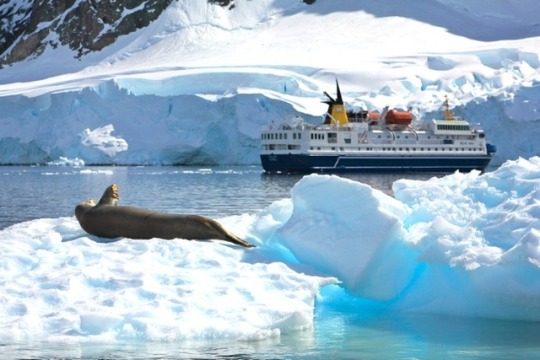
Original content owned & copyrighted by Green Global Travel.
It wasn’t all that long ago that the idea of taking an Antarctic vacation was little more than a pipe dream for most travelers.
Daring explorers such as Roald Amundsen and Ernest Shackleton captured worldwide attention with their Antarctic expeditions in the early 20th century. But regular travel didn’t become possible until the late 1960s, and only 14,762 people took a trip to in 1999-2000.
Antarctic adventures have become much more accessible in recent years, and tourist numbers have grown rapidly as a result. These days more than 40,000 people visit annually. Most of them are attracted by the diverse array of Antarctic animals, the incredible natural landscapes, and the extremophile species that can withstand hostile weather conditions. Then there are the various famous species of Antarctic Penguins, Seals, Endurance: Shackleton’s Incredible Voyage, or watch The Endurance or Shackleton.
With climate change at our doorstep and Antarctic ice melting at a rapid pace, the continent is now at a pivotal point in history. So here we’ll take a look at some of the many stunning animals of we think are worth saving for future generations to enjoy…
READ MORE: Fascinating Facts About the Blue Whale
Cruise Ship with Crabeater Seal on an Iceberg, by Bret Love & Mary Gabbett
BENEFITS OF TAKING AN A CRUISE
As previously mentioned, travel to has become more and more popular in recent years, thanks largely to the increasing availability of Antarctic cruises.
Some environmentalists have expressed concern about the effects Antarctic Treaty has numerous provisions that were designed to protect the planet’s most pristine ecosystem from the ravages of overtourism.
Massive cruise ships are not allowed to visit . But small ship cruises allow travelers to explore both the mainland and sub-Antarctic islands, whether via motorized zodiacs, kayaks, or on foot.
Human history in is just over 100 years old. But travelers will hear stories and visit historic sites (including scientific research stations) that help to illuminate our existence and persistence there.
is still a place where we, as humans, remain guests– observers who are not well-suited for long-term survival in such an extreme environment. An Antarctic holiday provides a picture of what the world looks like with minimal human footprint, while also showing where we might be heading due to our heavy carbon footprints elsewhere on the planet.
Taking an Antarctic cruise provides access to all of these insights and more. Modern cruise ships can endure the rough seas of the READ MORE: The World’s Best Small Ship Cruises (World Travel Bucket List)
ANIMALS
Antarctic Birds
Antarctic Penguins
Antarctic Seals
Antarctic Whales and Dolphins
Other Wildlife In
Photo by NOAA Photo Library, licensed under CC BY 2.0
BIRDS
The birds of are an exceptionally hardy sort. Antarctic birds tend to be large, seagoing, and require water-resistant plumage and layers of fatty insulation. They’re also incredibly plentiful: Over 100 million birds flock there in the spring months to nest and breed.
Many birds of the Antarctic can be spotted among the region’s myriad islands and mainland coasts. They often congregate in colossal colonies, taking advantage of those areas that aren’t snow-laden. Here are some of the coolest Antarctic birds you’re likely t0 spot during your cruise to :
Antarctic Skuas
With a wingspan that can measure over five feet, the Antarctic Skua (a.k.a. Brown Skua or Southern Great Skua) ranks among the biggest seabirds on the planet. They’re very intelligent and notoriously adept at stealing and snacking on Penguin eggs and chicks. Some scientists are putting the Antarctic Skua into three separate species, designating the Falkland Skua and Sub-Antarctic Skua as their own thing.
Blue-Eyed Shags
Mistaken as Giant Petrels
Yet another impressively large bird, the Giant Petrel can weigh in the ballpark of 17 pounds and have wings that span nearly seven feet! They range the southern seas and all the countries therein, including , Snowy Sheathbills
The only land bird native to continental , the Snowy Sheathbill is a ground-dweller that feeds on just about anything it can find, including Penguin vomit. This bird’s list of Wandering Albatross
Of the 10 species of Albatross in , the Wandering Albatross (a.k.a. Snow Albatross or Goonie) is the largest. Its wings can span more than 11 feet, and the long-distance flyer can weigh upwards of 24 pounds. Though these birds spend most of their lives flying (around 75,000 miles a year), they do settle down long enough to breed on the sub-Antarctic islands.
READ MORE: Beautiful Birds of the Galapagos Islands
King Penguins on South Georgia Island, photo by Donna Hull courtesy My Itchy Travel Feet
PENGUINS
Seeing Penguins in are often the highlight of a cruise to the frozen continent. There are six Penguin species spread across the mainland and surrounding islands, including Adélie, Chinstrap, Emperor, Gentoo, King, and Macaroni Penguins.
Even if your trip to only takes you to the mainland, you’re still virtually guaranteed to find yourself encountering numerous types of Penguins.
This is because the preferred Penguin habitat for nesting is right along the shore, where there’s typically little to no ice accumulation in summer (December through February in the southern hemisphere).
Adélie Penguins
Both the tiniest and most widely distributed species of Penguins in , Adélie Penguins stand around two feet tall and weigh around eight pounds. There are nearly 4 million breeding pairs, grouped into just over 250 colonies. Interesting Adélie Penguin facts include that they were named after the wife of Jules Dumont d’Urville, the explorer who discovered them. Other distinctive characteristics include a white ring around their eyes and black feathers concealing much of their red bills.
Chinstrap Penguins
As their name suggests, Chinstrap Penguins have a narrow black stripe beneath their chins. Due to an ear-piercing call, they are also sometimes referred to as Stonecracker Penguins. Chinstraps are the most prominent species on mainland , with an estimated population of 8 million. They also like to breed in Emperor Penguins
Emperor Penguins are famous for being the largest penguin in , standing around four feet and weighing around 50 pounds. They were brought to global prominence as the subject of the March of the Penguins. They tend to breed on the pack ice and shelf ice, though a few colonies have recently been seen inland on the Peninsula.
Gentoo Penguins
Gentoo Penguins are identified by the bonnet of white running across the back of their heads, and a bright orange beak on the front. They also have the longest tail of all the world’s Penguins. Other fascinating Gentoo Penguin facts includes them being the fastest (swimming up to 22 mph), and they actively shun colony members that stray from their partners. An estimated 600,000 Gentoo Penguins breed and nest on ’s iceless shorelines.
King Penguins
The second largest Penguin species, King Penguins can grow up to three feet tall and 40 pounds. They look similar to Emperor Penguins, but with a longer, straighter bill and more orange colorings as opposed to the Emperor’s mix of white, pink, and yellow. There are over 2 million breeding pairs of King Penguins on the sub-Antarctic islands, particularly the Crozets, South Georgia, and the Prince Edwards Islands.
Macaroni Penguins
Macaroni Penguins are also quite partial to the sub-Antarctic islands, especially Heard Island and South Georgia. They have serious orange bills for snouts and comical bright orange feathers that sweep across their foreheads like really long eyebrows, spiking out at the sides. Macaroni Penguins are on the smaller side, only growing to 27 inches tall and tipping the scales at about 10 pounds. They have a large, though currently declining population of nearly 9 million breeding pairs.
Southern Rockhopper Penguins
The stars of the 2007 animated film, Surf’s Up, Southern Rockhopper Penguins are tiny. They don’t even reach two feet tall, and barely weigh five pounds. Like the Macaronis, they have prominent orange beaks and distinctive eyebrow feathers. But the Southern Rockhopper’s eyebrows are yellow and twirl up at the outer edges. As their name suggests, they’re more likely seen jumping on rocks rather than waddling.
READ MORE: Penguins in Photo Essay
Crabeater Seal on an Iceberg by Bret Love & Mary Gabbett
SEALS
Much like an East Africa’s Seals in are excellent hunters. These pinnipeds (a group that also contains Walruses and Antarctic Fur Seals
The Antarctic Fur Seal is the only eared seal found in : The rest are “earless” or “true” seals, which are better adapted for swimming. Though small compared to other types of Seals, males can still reach over six feet long and exceed 200 pounds. More than 90% of the planet’s population breeds on the South Georgia Islands, in numbers that can be as large as four million in a given breeding season.
Crabeater Seals
With pale fur that helps them blend in, Crabeater Seals live on the pack ice of . They’re slender and long, reaching over eight feet from elongated snout to tail. Despite what their name suggests, Crabeater Seals don’t actually eat crabs (they prefer krill). They’re thought to be the most populous of all Seal species. In fact, after humans, they’re the most prevalent large mammal on the planet!
Leopard Seals
The Leopard Seal is the second largest of all land animals in , with females stretching to 11.5 feet and weighing 800-plus pounds. These predators are ferocious, hunting everything from fish and Penguins to Crabeater Seals. Its name derives from the black spots on its chest and underside. During the summer, male Leopard Seals spend several hours a day swimming upside down and singing underwater.
Southern Elephant Seals
The largest pinniped on the planet, Southern Elephant Seals dwarf even giant mammals like Weddell Seals
The most southerly living mammal in the world, Weddell Seals are named after British Captain James Weddell and inhabit ’s icy coasts. They have little heads and cute faces, reaching up to 10 feet long and 1300 pounds. They are dark with pale patches, particularly on their bellies. Weddell Seals like to swim below the ice, which protects them from predators and makes prey fish easier to see.
Ross Seals
Hanging out almost exclusively on Antarctic pack ice, Ross Seals are dark on top and silver below. They have huge eyes and are relatively small at around six feet long. Like Weddell Seals, they’re named after the British explorer who discovered them. Discovered over 150 years ago, they’re one of the least-studied Seal species. They’re noted for making twitter-y sounds, but we don’t yet know the purpose of this call.
READ MORE: Fascinating Facts About the Hawaiian Monk Seal
Humpback Whale in by Bret Love & Mary Gabbett
WHALES AND DOLPHINS
There is something incredible humbling about seeing Whales in up close. Whether it’s a full-on breaching or just the flip of a tail as it dives, their massive size puts the significance of us as humans into perspective.
Antarctic Whales are plentiful both in number as well as in diversity. There are 15 Whale species found in the continent’s waters, including the world’s biggest Whale, endangered Whales, and the most ferocious of the cetacean species.
Whale watching is truly an essential experience for anyone who cruises to . Here’s a look at some of the types of Whales you’re most likely to see:
Blue Whales
The Blue Whale is the largest Whale species and the largest animal ever to have existed (including dinosaurs), weighing 300,000 pounds and measuring nearly 100 feet long. Luckily, they are very gentle giants. Unfortunately, that has made them susceptible to IUCN’s endangered species list. The call of the Blue Whale is so loud that it can be heard underwater hundreds of miles away, making it the loudest animal on the planet as well.
Humpback Whales
Another extremely large baleen Whale, Humpbacks extend over 50 feet and reach more than 30 tons. They have exceptionally long pectoral fins, notably knobby heads, and sweet songs. Humpback Whales are visible in many places because they migrate some 16,000 miles a year, and they breach with ridiculous acrobatics. Unlike Blue Whales, Humpbacks have a sizable population some 80,000 strong.
Minke Whales
Though tiny in terms of cetaceans, Minke Whales still average more than 20 feet long (think London double-decker bus) and weigh up to 10 tons (think 8-10 cars). Southern Minke Whales like to frequent sub-Antarctic seas and are commonly sighted where flocks of seabirds are feeding. Unfortunately, much like Giant Petrels, they have the reputation of being a bit smelly.
Southern Right Whales
Once hunted to near extinction, Southern Long-finned Pilot Whales
Long-finned Orcas
Also known as Dusky Dolphins
Found only in the southern hemisphere, Dusky Dolphins are relatively small compared to other cetaceans– a little over 5.2 feet and around 160 pounds. They have small noses and beautiful markings, including white streaks along their sides and a bi-colored dorsal fin. They are coastal Dolphins, and are typically spotted swimming close to shore.
Hourglass Dolphins
Though an unlikely sighting, the rare Hourglass Dolphin is occasionally found swimming in Antarctic waters. The species’ classification is based largely on eyewitness accounts, and less than a dozen Hourglass Dolphins have been studied. They’re mostly black, with patches of white along the back that resemble an hourglass. They have stocky bodies, under 6 feet long and possibly over 250 pounds. They travel in pods of ten or less and are most often seen feeding alongside other groups of cetaceans.
READ MORE:
Tardigrade (a.k.a. Water Bear) by yourlocal-t-rex, licensed under CC PDM 1.0
WILDLIFE IN A
While Penguins, Seals, and Whales rightfully dominate the show, there are other species of interesting wildlife, including large seafaring creatures and miniscule land dwellers. You won’t likely see these Colossal Squids
You’ve probably heard of the Giant Squid, but the Colossal Squid (a.k.a. Antarctic Squid) is even larger. It has a bigger mantle and shorter tentacles (proportionally), and reportedly reaches nearly 50 feet in length and over 1,000 pounds. Its eyes are believed to be over a foot in diameter. Colossal Squids have been spotted in seas around Icefish
Denizens of the ice-cold waters of Antarctic seas, Icefish are notable because they have unusual blood. Unlike most animals, which have hemoglobin that carries oxygen and turns their blood red, Icefish lack hemoglobin, and thus have somewhat translucent blood. Scientists still aren’t quite sure how Icefish get enough oxygen around their bodies.
Flightless Midges
Despite a name that suggests it is nothing more than a smidge, the flightless Antarctic Midge is the largest (purely) land animal on . They measure a whopping half-inch long, stay in their larvae stage for about two years, then have a lifespan of roughly 10 days as adults.
Tardigrades
Too weird, disturbing, and/or cute (depending on your perspective) to ignore, tardigrades are tiny little creatures that are just over a millimeter in size. They’re often called “water bears” because they have plump bodies and stuffed animal-like qualities. In my eyes they look a little like the caterpillar from Disney’s Alice In Wonderland. Amazingly, they can withstand temperatures below -300º Fahrenheit, as well as survive in outer space. –Jonathon Engels
The post 30 Antarctic Animals You Can See on an Cruise appeared first on Green Global Travel.
#><strong>icebergs</strong></span></a>#008000;#><strong>Dolphins</strong></span></a>#>Drake#ANTARCTIC#OTHER#><strong>Cormorants</strong></span></a>.#><strong>Australia</strong></span></a>#>South#><strong>South#>documentary</span></strong></a>#>Sea#><strong>Elephant</strong></span></a>#>Right#><strong>Killer#><strong>weird
0 notes
Text
21 quotes from the Apollo 11 astronauts on everything from walking on the moon to the future of spaceflight
https://theattainer.com/wp-content/uploads/2020/07/neil-armstrong-post-moon-walk-attainer.jpeg
https://theattainer.com/21-quotes-from-the-apollo-11-astronauts-on-everything-from-walking-on-the-moon-to-the-future-of-spaceflight/
21 quotes from the Apollo 11 astronauts on everything from walking on the moon to the future of spaceflight
Half a century ago, on July 16, 1969, the Apollo 11 astronauts took off for the moon.
Neil Armstrong, Edwin “Buzz” Aldrin, and Michael Collins arrived four days later to a place no human being had ever been before.
Collins orbited the moon while Armstrong and Aldrin landed on its surface. It took them hours to put on their space suits and prep for touchdown. After descending the ladder onto the lunar surface, Armstrong uttered his historic words: “That’s one small step for man, one giant leap for mankind.” (Armstrong would later claim, “‘That’s one small step for ‘a’ man.’ It’s just that people just didn’t hear it.”)
The 600 million people watching the moon landing on television would remember that line. But the three astronauts had much more to say about their experience flying to the moon and back.
Here are the astronauts’ most memorable words.
Neil Armstrong on vision
Astronaut Neil Armstrong smiles inside the Lunar Module July 20, 1969.
NASA via Getty Images
“There are great ideas undiscovered, breakthroughs available to those who can remove one of truth’s protective layers. There are places to go beyond belief.”
Source: United Press International
Buzz Aldrin on dreams
NASA/AP
“One truth I have discovered for sure: When you believe that all things are possible and you are willing to work hard to accomplish your goals, you can achieve the next ‘impossible’ dream. No dream is too high!”
Source: “No Dream is Too High: Life Lessons From a Man Who Walked on the Moon”
Buzz Aldrin on keeping an open mind
NASA/AP
“Your mind is like a parachute: If it isn’t open, it doesn’t work.”
Source: “No Dream is Too High: Life Lessons From a Man Who Walked on the Moon”
Neil Armstrong on challenges (answered during Apollo 11’s pre-flight news conference)
Getty
“I think we’re going to the moon because it’s in the nature of the human being to face challenges. It’s by the nature of his deep inner soul … we’re required to do these things just as salmon swim upstream.”
Source: Internet Archive
Michael Collins on liftoff
Apollo 11 command module pilot astronaut Michael Collins during a break in training for the July 1969 moon landing journey in Cape Kennedy, Florida, June 19, 1969. Astronauts Neil Armstrong and Edwin (Buzz) Aldrin Jr., took a walk on the lunar surface, while Collins circled alone in moon orbit.
AP Photo
“We are off! And do we know it, not just because the world is yelling ‘Liftoff’ in our ears, but because the seats of our pants tell us so! Trust your instruments, not your body, the modern pilot is always told, but this beast is best felt. Shake, rattle and roll!”
Source: “Carrying the Fire: An Astronaut’s Journeys”
Buzz Aldrin on weightlessness
Buzz Aldrin poses in an Apollo 11 spacesuit in July 1969, just days before launching toward the first human landing on the moon.
NASA
“There’s a tremendously satisfying freedom associated with weightlessness. It’s challenging in the absence of traction or leverage, and it requires thoughtful readjustment. I found the experience of weightlessness to be one of the most fun and enjoyable, challenging and rewarding, experiences of spaceflight. Returning to Earth brings with it a great sense of heaviness, and a need for careful movement. In some ways it’s not too different from returning from a rocking ocean ship.”
Source: Scholastic
Neil Armstrong after landing on the moon
Public Domain
“Houston, Tranquility Base here. The Eagle has landed.”
Source: NASA
Neil Armstrong’s first words on the moon
NASA/AP
“That’s one small step for man, one giant leap for mankind.”
Source: NASA
Neil Armstrong on his famous quote
Astronaut Edwin E. “Buzz” Aldrin Jr. poses for a photograph beside the US flag deployed on the moon during the Apollo 11 mission on July 20, 1969
AP Photo/NASA/Neil A. Armstrong
“I thought, well, when I step off it’s just going to be a little step — a step from there down to there — but then I thought about all those 400,000 people who had given me the opportunity to make that step and thought it’s going to be a big something for all those folks and, indeed for a lot of others that weren’t even involved in the project, so it was kind of a simple correlation.”
Source: CBS News
Neil Armstrong on his moonwalk
NASA
“Pilots take no special joy in walking: pilots like flying. Pilots generally take pride in a good landing, not in getting out of the vehicle.”
Source: “In the Shadow of the Moon”
Buzz Aldrin on the lunar surface
NASA
“Magnificent desolation.”
Source: “Magnificent Desolation: The Long Journey Home from the Moon”
Neil Armstrong on the lunar surface
Astronaut Edwin E. Aldrin Jr. walks on the surface of the moon, July 30, 1969, with seismogaphic equipment which he just set up. The flag like object on a pole is a solar wind experiment and in the background is the Lunar Landing Module.
AP Photo/NASA/Neil Armstrong
“It’s an interesting place to be. I recommend it.”
Source: CBS News
Michael Collins on looking down at Earth
NASA
“I really believe that if the political leaders of the world could see their planet from a distance of, let’s say 100,000 miles, their outlook would be fundamentally changed. The all-important border would be invisible, that noisy argument suddenly silenced.”
Source: Michael Collins on Twitter
Michael Collins on orbiting the moon alone
Project Apollo Archive
“I am alone now, truly alone, and absolutely isolated from any known life. I am it. If a count were taken, the score would be three billion plus two over on the other side of the moon, and one plus God knows what on this side.”
Source: “Carrying the Fire: An Astronaut’s Journeys”
Buzz Aldrin on looking back at Earth
NASA
“From the distance of the moon, Earth was four times the size of a full moon seen from Earth. It was a brilliant jewel in the black velvet sky. Yet it was still at a great distance, considering the challenges of the voyage home.”
Source: Scholastic
Buzz Aldrin on being the second man on the moon
“As the senior crew member, it was appropriate for [Armstrong] to be the first. But after years and years of being asked to speak to a group of people and then be introduced as the second man on the moon, it does get a little frustrating. Is it really necessary to point out to the crowd that somebody else was first when we all went through the same training, we all landed at the same time and all contributed? But for the rest of my life I’ll always be identified as the second man to walk on the moon. [Laughs.]”
Source: National Geographic
Buzz Aldrin on returning to space
“Everyone who’s been in space would, I’m sure, welcome the opportunity for a return to the exhilarating experiences there. For me, a flight in a shuttle, though most satisfying, would be anticlimactic after my flight to the moon.”
Source: Scholastic
Neil Armstrong on being an engineer
NASA/Reuters
“I am, and ever will be, a white-socks, pocket-protector, nerdy engineer — born under the second law of thermodynamics, steeped in the steam tables, in love with free-body diagrams, transformed by Laplace, and propelled by compressible flow.”
Source: National Academy of Engineering
Michael Collins on Mars
“I see more moon missions as delaying Mars, which is a much more interesting place to go.”
Source: United Press International
Neil Armstrong on lunar bases
Alex Brandon/AP
“Oh, I am quite certain that we will have such bases in our lifetime, somewhat like the Antarctic stations and similar scientific outposts — continually manned. Although, certainly there is the problem of the environment, the vacuum, the high and low temperatures of day and night. Still, in all, in many ways, it’s more hospitable than Antarctica might be.”
Source: BBC interview via Business Insider
Buzz Aldrin on exploration
NASA/AP
“The urge to explore has propelled evolution since the first water creatures reconnoitered the land. Like all living systems, cultures cannot remain static; they evolve or decline. They explore or expire.”
What do you think?
0 notes
Text
Hazel Edwards
Hazel Edwards writes quirky, thought-provoking fiction and fact for adults and children. Coping successfully with being different is a common theme. Co-written ‘junior novel ‘Hijabi Girl’ explores cultural diversity and is to be a Larrikin Puppets’ musical in 2020.
Best known for ‘There’s a Hippopotamus on Our Roof Eating Cake’ series, recently touring as a musical, Hazel has grandkids for whom she writes a story each birthday. ‘Outback Ferals’ her YA novel set in Darwin, is a sequel to ‘Antarctica’s Frozen Chosen’, researched during her 2001 Antarctic expedition.
Hazel runs book-linked workshops on ‘Authorpreneurship’ and ‘Writing a Non Boring Family History’. ‘Complete Your Book in a Year’ is run at PROV (Public Records Office) and all finish their memoirs or history based books.
A National Reading Ambassador, in 2013 Hazel was awarded an OAM for Literature. Her memoir ‘Not Just a Piece of Cake-Being an Author’ explores longterm creativity.
Also on Audible, ‘Celebrant Sleuth; I do or die’ an adult mystery with Quinn her innovative sleuth who continues in ‘Wed, Then Dead on the Ghan’ mini sequel. ‘Almost a Crime’, short crimelettes are also available on Kindle.
‘Ho! Ho! Ho There’s a Hippopotamus on Out Roof Eating Christmas Cake (Penguin) is the seventh and last in the classic picture book series. 2020 is the 40th anniversary celebration of the cake-eating hippo.
2012 Ambassador for National Year of Reading, and three times (2010, 2011, and 2012) nominee ALMA award, Hazel, received Order of Australia Medal (OAM) for literature in 2013. Hazel became the Soceity of Women Writers' Patron in 2013.
In the two years, since you were last interviewed, the genre in which you write has changed from children to adult mystery/crime. Formats have changed too. And some earlier works have moved into new mediums like comic graphic novels. Why was that?
Although my cake-eating hippo character is celebrating 40 years of being constantly in print and three generations have loved him, I wanted a new plotting challenge which could use varied settings. I always wrote across genres, but the hippo picture books were the best known.
Quinn, my sleuth character works as a celebrant, and this enables her to move into different cultures and geographic settings for each story which is a self contained chapter in the original longer work. She’s a quirky problem solver and murder isn’t always on the agenda.
Originally I wrote her with a series in mind, and thought she would adapt well to television. That hasn’t happened, YET. But she has travelled onto AUDIBLE via my voice.
Learning to audio record such a long novel work was a new experience although I had recorded shorter picture books and junior novels like ‘Hijabi Girl’. Just the sheer length of 9 hours finished audio story indicates much longer rehearsal/recording time. Took about four months, with studio visits twice weekly. Spring Studio producer Harry Williamson was very patient with me. But having an author record their own story in studio gives special nuances and having a female Australian voice was vital as my Quinn character is of diverse gender and most AUDIBLE actor voices are American.
As an author I’m an intellectual risk-taker and hope my innovations will be seen as strengths not weaknesses. But sometimes, the timing is wrong.
‘Wed, Then Dead on The Ghan’ is a mini- sequel to ‘Celebrant Sleuth; I Do or Die’ and I had qualms about its brevity as a stand-alone but the story actually matched the length of earlier chapters of complete stories in the original book which I had designed as possible TV episodes.
My working methods have changed too. I write 6am-8 am on original fiction as mysteries are the most challenging to plot and I need to be mentally fresh. As a fulltime writer with a big backlist, the literary administivia seems to be growing. Other authors have also commented on this escalation too because with new formats which require clarification of rights, copyright issues or pirates pinching stuff, the legal aspects and form filling and filing of authors’ work is more complicated and takes time from new work.
So although ‘Wed, Then Dead on The Ghan’ is only 7,000 words and a mini sequel in e book and a cute, small format, I know exactly how long it took. After a research trip on the Ghan from Adelaide to Darwin in late January, I wrote 2 hours every morning, until late June. Then it was edited, the cover designed and published by October. Earlier I had taken over a year to write the original Quinn ‘Celebrant Sleuth’ but for that initial concept , characters had to be developed and a country town scenario which was used in subsequent stories. With ‘The Ghan’ story I had to check facts about the real train but also it was an experiment in writing ‘short’ for e-format. And of experimenting with a tiny book format which sells at 99 cents on Amazon
Having a versatile character like a celebrant enables me to utilize different settings and include my travel research. So I live more intensively by looking at what might go wrong. Tends to worry the OH&S people.
What are one to three books that have greatly influenced your life?
Probably the first one I was able to read by myself influenced me the most. There was a joy in cracking the code of the words. And I can remember Blyton’s ‘The Land of Far Beyond’ which was my first experience of a book with subtext which was a kind of quest and not just a ‘what happens next’ story for kids. Although I had a Grandma who read me lots of stories, and who taught me to read, I didn’t know Blyton’s book was a children’s version of ‘Bunyan’s Pilgrim’s Progress,’ but I liked the ‘journey with a purpose’ structure. That’s what writers do in real life travel-research: travel with a purpose. (But didn’t know then I’d go to Antarctica etc to write).
George Orwell’s ‘Animal Farm’ influenced me as a student when I realized it wasn’t just about animals taking over the farm, it was a political and historical allegory. So although I am not religious nor political in adulthood, I’m drawn to books which have layers of thought as well as a good story and insight into another world. Possible why I take cultural risks in some of the subjects about which I’ve co-written, such as ‘Hijabi Girl’ and ‘f2m; the boy within’ about trans youth and my asexual sleuth Quinn in adult mystery ‘Celebrant Sleuth: I do or Die’.
How has a failure, or apparent failure, set you up for later success?
Most writers struggle to survive financially. They are short of time, money and get little recognition at the beginning. Add to that family responsibilities and there’s not much slack. I coined the term ‘Authorpreneur’ where a writer becomes a solo practitioner in the small business of ideas. Being an author requires a portfolio of skills, but you also need to retain a quirky enjoyment in your subjects.
And it’s part of seeing yourself as a business, not a victim of rejection. So you pitch ideas, have a business plan and keep to deadlines. You also choose your projects with a specific audience in mind. And if you get rejected, you recycle in another format or to another publisher.
But occasionally your subjects may be ahead of current interests. We got 41 rejections on ‘Hijabi Girl’ and now it has been reprinted several times as social issues and perceptions have changed. Larrikin Puppets have created a musical puppetry show for 2020 Book Week and were oversubscribed when they used crowdfunding to help with puppet development. Society now wants works to explore tolerance, not hate, especially after the NZ Christchurch terrorist bombing.
The concept of coping successfully with being different has always intrigued and this had meant some risky cultural research in gender areas. And physical research in places like Antarctica where I was an expeditioner with the Australian Antarctic Division in 2001.
As a teenager I worked in my family country general store before and after school and at weekends. Although I wasn’t keen at the time, it gave me exposure to gossip (research for a writer), ability to say ‘No’, handling maths via money and a work ethic of the self employed. I knew a 9-5 occupation was not for me. Neither was a routine job.
Often when things have gone wrong, that provides drama for writing. The best stories come from things going wrong like our leaking roof which lead to the children classic picture book series ‘There’s a Hippopotamus on Our Roof Eating Cake’. Everybody has ‘failures’, it’s what you do about them afterwards that matters. A writer can utilize the feelings in their characters to create more realistic drama.
Are there any quotes you live your life by?
Persist. Read widely. Choose others with a similar work ethic. Have fun. Do participant-observation research where you ‘go and do’ in order to write realistically afterwards. I’ve been hot air ballooning, trekked in Nepal, visited a funeral parlour behind the scenes and experienced ‘a working day in the life of a ‘fireworks expert’ (pyrotechnician), oil rig engineer and even a chopper pilot.
I tend to decide in the general direction in which I want to go, such as children’s theatre or learning to audio record and then look for opportunities to acquire the skills by collaborating with others, or taking on small projects. Or I might get interested in subjects such as celebrants (prior to my adult mystery ‘Celebrant Sleuth I do or Die’ ) and immerse myself in their workstyle. I collect anecdotes which are mini stories.
Now I’m officially ‘old’ (you can tell the age of authors by checking their year of birth on the publisher’s page at the front of the book) I’m continuing to work on creative projects as writers never retire. That’s a bonus.
Child-like enthusiasm is the answer for a longterm career as a writer, so you continually to be enthused and write fresh material for your readers. Not the same book ten times. Be wary of the thinly disguised memoir of a writer not being able to write and blaming on writers’ block.
What is one of the best investment in a writing resource you’ve ever made?
The Iphone has enabled me to take photos at literary events and use them immediately on social media. I’m not visual nor a good photographer, but have learnt to crop and get one generic photo of me holding the relevant book against a relevant background, which can be used many times. e.g. Our co-creators photo of Hijabi Girl launch.
As an author speaker, the IPad is the most useful device. Fewer props to carry as I can have dot points in the size font I can read on a speakers’ platform. Instead of actual books I can carry covers only. And I now use the ‘notes’ via the Cloud, to transfer between my devices. That saves repetition.
For exercise I listen to audio books as I walk and these run from my IPad now that airlines permit you to use this device inflight. So I can work on existing files which I have preloaded. I’m answering these interview questions while at the hairdresser prior to a photo shoot as an author
I also have my generic talks on a usb which can go into my hosts’ computer and show via data projector. Also carry a backup on a brightly colored cord in case usb gets lost or forgotten. My usb talks are mainly quirky and versatile visuals which can be used with different aged and types of audiences. The aim is generic props.
I’m not a digital native but I aim to learn one tiny digital skill per day, it might be as small as how to attach a hashtag to a Tweet. My marketing manager daughter overhauled me digitally with an updated author website about ten years ago. She also taught me to think and write for a visual generation via Twitter etc and learn to use photos whereas I think in abstract.
So writers need to continue to learn. Currently I’ve enrolled for a forensic DNA weekend course, to improve my knowledge of police procedures and to ensure I don’t make factual mistakes in plots.
What is an unusual habit or an absurd thing that you love?
I’ve been doing Belly Dancing 101 on Monday nights 6.30-7.30 for 13 years. It’s my therapy. I meet women who lead very different lives from me and we all listen to each other.
In the last five years, what new belief, behaviour, or habit has most improved your life?
It’s impossible to fit in everything and life can become stuffed with ‘should do’ things. So just do part of one tiny task towards the ‘big project’. Start with jotted notes. Or just answer ONE question in a blog interview like this, even if you have to leave in 10 minutes. Instead of keeping a ‘To Do’ list, I write DONE. DETOUR or USELESS. Detour, means to have another go later. Aware that I need to de-clutter my literary files. So I try one small area late in the day when I tend to be braindead.
What advice would you give to a smart, driven aspiring author? What advice should they ignore?
Teach your family to cook. I object to the use of ‘writers’ block’ as an excuse for not producing. A disciplined writer can produce to a deadline, but not all the experience may be euphoric. In my memoir ‘Not Just a Piece of Cake: Being a Writer’ (Brolga) I explore the ‘Plateau of Boredom’. Collaborating with digitally skilled, younger co-creators helps you learn new formats for stories, and there’s a purpose in the learning by doing.
Recently our ‘f2m;the boy within’ inspired the development of a graphic comic novel ‘The Boy Within’. This concept is still in progress with the two transguys who are familiar with the constantly changing gender language and issues. So acknowledge when you need to delegate or seek expert help. Getting the language right for your audience is vital. Extract: The Plateau of Boredom
The Process of Creativity: or the Writer’s Block You’re Not Having! Creativity is a map. I have to reach a plateau of boredom, a feeling that everything is flat and monotonous. To avoid the ‘nothing- ness’, I put two things together that have never been in that combination before, which become a new idea for a story.
To avoid being stuck on that plateau forever, I write an alternative mental world which provides the terrain of variety. Rivers of thoughts. Occasional peaks. Rocky stretches of plotting when I have to find alternative routes. And glimpses of characters. (Now I could have added ‘in the fog’ but that would have been stretching the analogy).
This morning I woke up with that map image. I hadn’t thought of creativity quite in that way before. Early mornings are when I have my best ideas, before the minutia of domesticity takes over. That’s why when my children were younger; I did my best snatched writing before they woke or when I was away alone in motels on author tours.
On reflection, perhaps weekly family orienteering on Sundays provided the map image. Trying to find an elusive control on a bush map when you’re tired, knowing it’s there somewhere, but you have to stop, and rest for a moment. And then I’d go back and try to find the route, like plotting a novel. Using an existing map is one challenge. Creating the map is another.
What marketing tactics should authors avoid?
Ego. There’s a difference between marketing the subject of a book, and trying to play ‘celebrity’. Always consider what your audience wants to know. And craft it for them.
What new realizations helped you achieve your goals?
Co-write if you intend to be a long term author, so you will continue to learn in new areas. Be willing to constantly learn new skills as the means and format of conveying ideas and stories changes.
And if you are writing of another culture, having a co-author from that culture ensures your work is authentic. You also feel morally obliged to finish your share before your next meeting, so it’s a great way to overcome procrastination.
Recently my 20 year old YA novel ‘Fake I.D.’ was translated into Tamil and launched in Chennai, India. It was a thrill to realise a story had not dated and was moving into a new culture.
The developments in multi-media have meant that ‘old’ stories can be adapted into new mediums. ‘Hippo Hippo the Musical’ the Garry Ginivin production has toured nationally and was inspired by the cake eating series of hippo picture books. Sitting in the audience, watching the actors AND the audience gave me great creative satisfaction.
Any other tips?
Stop reading ‘How To Write’ articles and actually start producing.
________
Enjoyed this Q&A? Want to discuss in more depth? Join Community Writers. You'll get access to 100+ exclusive writing tips. Q&As with successful authors, an exclusive ebook on building an audience and much more. Sign-up for free as a community writer here
0 notes